Financial Decision Making: Evaluating Accountancy and Financial Operations
VerifiedAdded on 2023/06/11
|17
|5761
|439
AI Summary
This article evaluates accountancy and financial operations to make financial decisions. It covers the options of capital for company success and development and calculating ratios. The subject is finance, and the course code is not mentioned. The course name and college/university are not mentioned either.
Contribute Materials
Your contribution can guide someone’s learning journey. Share your
documents today.

FINANCIAL
DECISION MAKING
DECISION MAKING
Secure Best Marks with AI Grader
Need help grading? Try our AI Grader for instant feedback on your assignments.
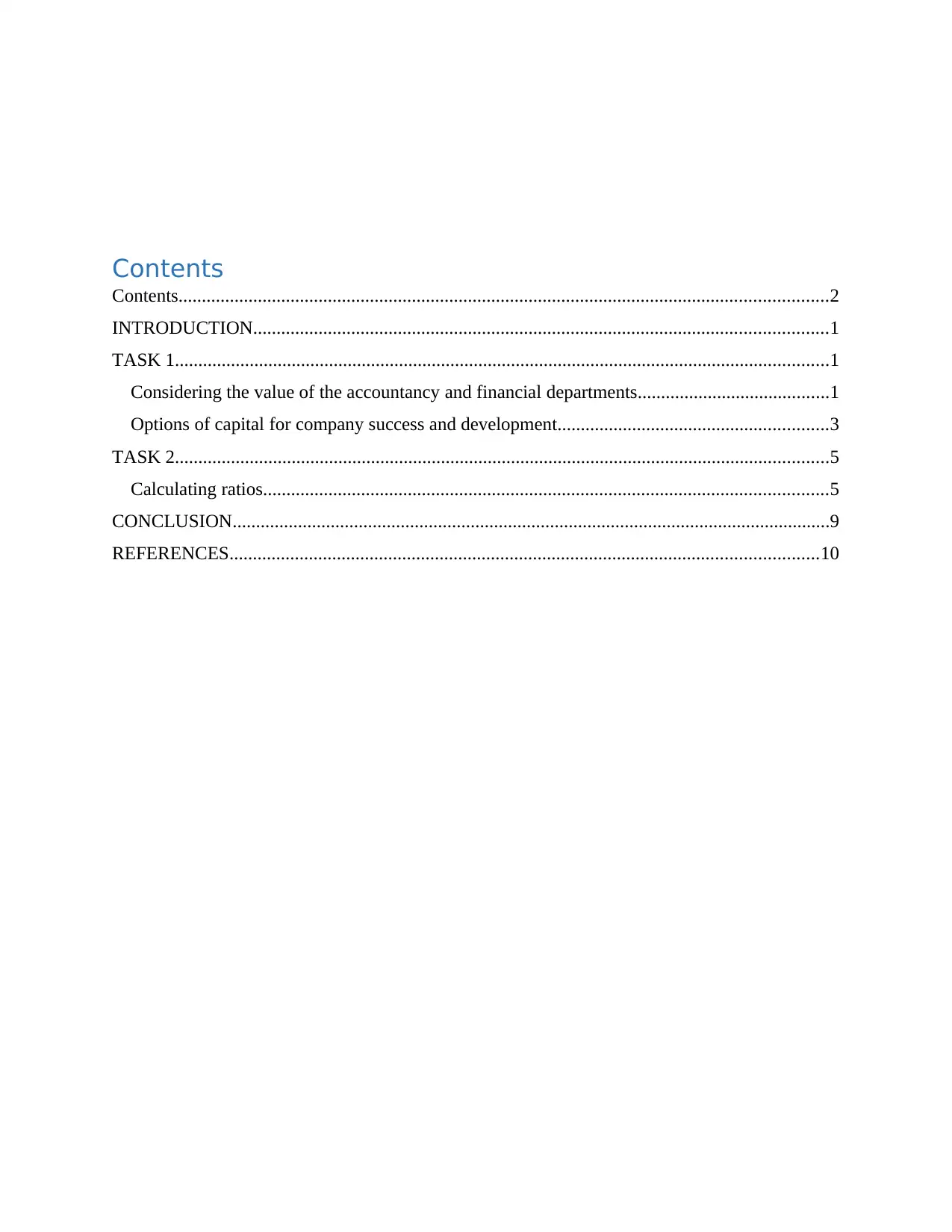
Contents
Contents...........................................................................................................................................2
INTRODUCTION...........................................................................................................................1
TASK 1............................................................................................................................................1
Considering the value of the accountancy and financial departments.........................................1
Options of capital for company success and development..........................................................3
TASK 2............................................................................................................................................5
Calculating ratios.........................................................................................................................5
CONCLUSION................................................................................................................................9
REFERENCES..............................................................................................................................10
Contents...........................................................................................................................................2
INTRODUCTION...........................................................................................................................1
TASK 1............................................................................................................................................1
Considering the value of the accountancy and financial departments.........................................1
Options of capital for company success and development..........................................................3
TASK 2............................................................................................................................................5
Calculating ratios.........................................................................................................................5
CONCLUSION................................................................................................................................9
REFERENCES..............................................................................................................................10

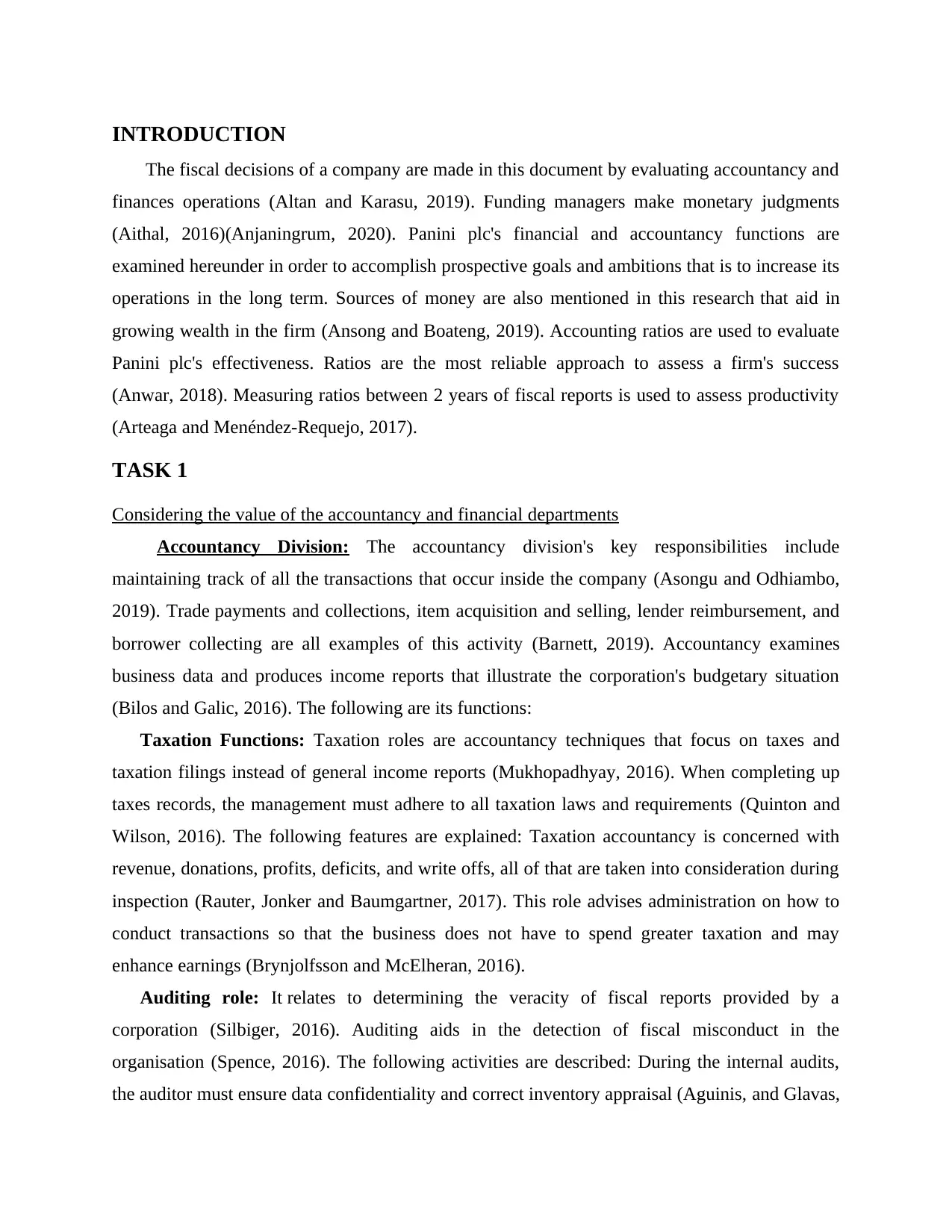
INTRODUCTION
The fiscal decisions of a company are made in this document by evaluating accountancy and
finances operations (Altan and Karasu, 2019). Funding managers make monetary judgments
(Aithal, 2016)(Anjaningrum, 2020). Panini plc's financial and accountancy functions are
examined hereunder in order to accomplish prospective goals and ambitions that is to increase its
operations in the long term. Sources of money are also mentioned in this research that aid in
growing wealth in the firm (Ansong and Boateng, 2019). Accounting ratios are used to evaluate
Panini plc's effectiveness. Ratios are the most reliable approach to assess a firm's success
(Anwar, 2018). Measuring ratios between 2 years of fiscal reports is used to assess productivity
(Arteaga and Menéndez-Requejo, 2017).
TASK 1
Considering the value of the accountancy and financial departments
Accountancy Division: The accountancy division's key responsibilities include
maintaining track of all the transactions that occur inside the company (Asongu and Odhiambo,
2019). Trade payments and collections, item acquisition and selling, lender reimbursement, and
borrower collecting are all examples of this activity (Barnett, 2019). Accountancy examines
business data and produces income reports that illustrate the corporation's budgetary situation
(Bilos and Galic, 2016). The following are its functions:
Taxation Functions: Taxation roles are accountancy techniques that focus on taxes and
taxation filings instead of general income reports (Mukhopadhyay, 2016). When completing up
taxes records, the management must adhere to all taxation laws and requirements (Quinton and
Wilson, 2016). The following features are explained: Taxation accountancy is concerned with
revenue, donations, profits, deficits, and write offs, all of that are taken into consideration during
inspection (Rauter, Jonker and Baumgartner, 2017). This role advises administration on how to
conduct transactions so that the business does not have to spend greater taxation and may
enhance earnings (Brynjolfsson and McElheran, 2016).
Auditing role: It relates to determining the veracity of fiscal reports provided by a
corporation (Silbiger, 2016). Auditing aids in the detection of fiscal misconduct in the
organisation (Spence, 2016). The following activities are described: During the internal audits,
the auditor must ensure data confidentiality and correct inventory appraisal (Aguinis, and Glavas,
The fiscal decisions of a company are made in this document by evaluating accountancy and
finances operations (Altan and Karasu, 2019). Funding managers make monetary judgments
(Aithal, 2016)(Anjaningrum, 2020). Panini plc's financial and accountancy functions are
examined hereunder in order to accomplish prospective goals and ambitions that is to increase its
operations in the long term. Sources of money are also mentioned in this research that aid in
growing wealth in the firm (Ansong and Boateng, 2019). Accounting ratios are used to evaluate
Panini plc's effectiveness. Ratios are the most reliable approach to assess a firm's success
(Anwar, 2018). Measuring ratios between 2 years of fiscal reports is used to assess productivity
(Arteaga and Menéndez-Requejo, 2017).
TASK 1
Considering the value of the accountancy and financial departments
Accountancy Division: The accountancy division's key responsibilities include
maintaining track of all the transactions that occur inside the company (Asongu and Odhiambo,
2019). Trade payments and collections, item acquisition and selling, lender reimbursement, and
borrower collecting are all examples of this activity (Barnett, 2019). Accountancy examines
business data and produces income reports that illustrate the corporation's budgetary situation
(Bilos and Galic, 2016). The following are its functions:
Taxation Functions: Taxation roles are accountancy techniques that focus on taxes and
taxation filings instead of general income reports (Mukhopadhyay, 2016). When completing up
taxes records, the management must adhere to all taxation laws and requirements (Quinton and
Wilson, 2016). The following features are explained: Taxation accountancy is concerned with
revenue, donations, profits, deficits, and write offs, all of that are taken into consideration during
inspection (Rauter, Jonker and Baumgartner, 2017). This role advises administration on how to
conduct transactions so that the business does not have to spend greater taxation and may
enhance earnings (Brynjolfsson and McElheran, 2016).
Auditing role: It relates to determining the veracity of fiscal reports provided by a
corporation (Silbiger, 2016). Auditing aids in the detection of fiscal misconduct in the
organisation (Spence, 2016). The following activities are described: During the internal audits,
the auditor must ensure data confidentiality and correct inventory appraisal (Aguinis, and Glavas,
Secure Best Marks with AI Grader
Need help grading? Try our AI Grader for instant feedback on your assignments.
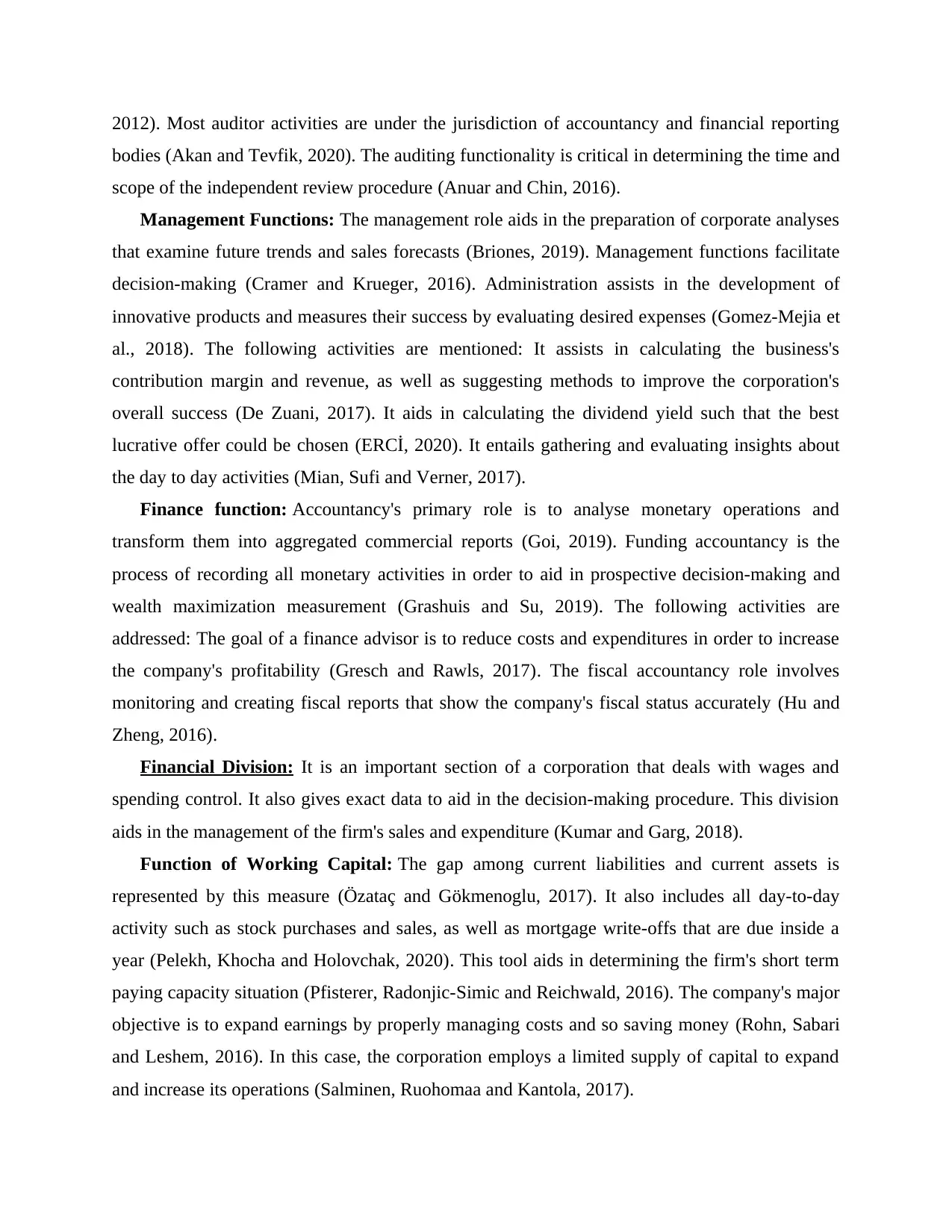
2012). Most auditor activities are under the jurisdiction of accountancy and financial reporting
bodies (Akan and Tevfik, 2020). The auditing functionality is critical in determining the time and
scope of the independent review procedure (Anuar and Chin, 2016).
Management Functions: The management role aids in the preparation of corporate analyses
that examine future trends and sales forecasts (Briones, 2019). Management functions facilitate
decision-making (Cramer and Krueger, 2016). Administration assists in the development of
innovative products and measures their success by evaluating desired expenses (Gomez-Mejia et
al., 2018). The following activities are mentioned: It assists in calculating the business's
contribution margin and revenue, as well as suggesting methods to improve the corporation's
overall success (De Zuani, 2017). It aids in calculating the dividend yield such that the best
lucrative offer could be chosen (ERCİ, 2020). It entails gathering and evaluating insights about
the day to day activities (Mian, Sufi and Verner, 2017).
Finance function: Accountancy's primary role is to analyse monetary operations and
transform them into aggregated commercial reports (Goi, 2019). Funding accountancy is the
process of recording all monetary activities in order to aid in prospective decision-making and
wealth maximization measurement (Grashuis and Su, 2019). The following activities are
addressed: The goal of a finance advisor is to reduce costs and expenditures in order to increase
the company's profitability (Gresch and Rawls, 2017). The fiscal accountancy role involves
monitoring and creating fiscal reports that show the company's fiscal status accurately (Hu and
Zheng, 2016).
Financial Division: It is an important section of a corporation that deals with wages and
spending control. It also gives exact data to aid in the decision-making procedure. This division
aids in the management of the firm's sales and expenditure (Kumar and Garg, 2018).
Function of Working Capital: The gap among current liabilities and current assets is
represented by this measure (Özataç and Gökmenoglu, 2017). It also includes all day-to-day
activity such as stock purchases and sales, as well as mortgage write-offs that are due inside a
year (Pelekh, Khocha and Holovchak, 2020). This tool aids in determining the firm's short term
paying capacity situation (Pfisterer, Radonjic-Simic and Reichwald, 2016). The company's major
objective is to expand earnings by properly managing costs and so saving money (Rohn, Sabari
and Leshem, 2016). In this case, the corporation employs a limited supply of capital to expand
and increase its operations (Salminen, Ruohomaa and Kantola, 2017).
bodies (Akan and Tevfik, 2020). The auditing functionality is critical in determining the time and
scope of the independent review procedure (Anuar and Chin, 2016).
Management Functions: The management role aids in the preparation of corporate analyses
that examine future trends and sales forecasts (Briones, 2019). Management functions facilitate
decision-making (Cramer and Krueger, 2016). Administration assists in the development of
innovative products and measures their success by evaluating desired expenses (Gomez-Mejia et
al., 2018). The following activities are mentioned: It assists in calculating the business's
contribution margin and revenue, as well as suggesting methods to improve the corporation's
overall success (De Zuani, 2017). It aids in calculating the dividend yield such that the best
lucrative offer could be chosen (ERCİ, 2020). It entails gathering and evaluating insights about
the day to day activities (Mian, Sufi and Verner, 2017).
Finance function: Accountancy's primary role is to analyse monetary operations and
transform them into aggregated commercial reports (Goi, 2019). Funding accountancy is the
process of recording all monetary activities in order to aid in prospective decision-making and
wealth maximization measurement (Grashuis and Su, 2019). The following activities are
addressed: The goal of a finance advisor is to reduce costs and expenditures in order to increase
the company's profitability (Gresch and Rawls, 2017). The fiscal accountancy role involves
monitoring and creating fiscal reports that show the company's fiscal status accurately (Hu and
Zheng, 2016).
Financial Division: It is an important section of a corporation that deals with wages and
spending control. It also gives exact data to aid in the decision-making procedure. This division
aids in the management of the firm's sales and expenditure (Kumar and Garg, 2018).
Function of Working Capital: The gap among current liabilities and current assets is
represented by this measure (Özataç and Gökmenoglu, 2017). It also includes all day-to-day
activity such as stock purchases and sales, as well as mortgage write-offs that are due inside a
year (Pelekh, Khocha and Holovchak, 2020). This tool aids in determining the firm's short term
paying capacity situation (Pfisterer, Radonjic-Simic and Reichwald, 2016). The company's major
objective is to expand earnings by properly managing costs and so saving money (Rohn, Sabari
and Leshem, 2016). In this case, the corporation employs a limited supply of capital to expand
and increase its operations (Salminen, Ruohomaa and Kantola, 2017).
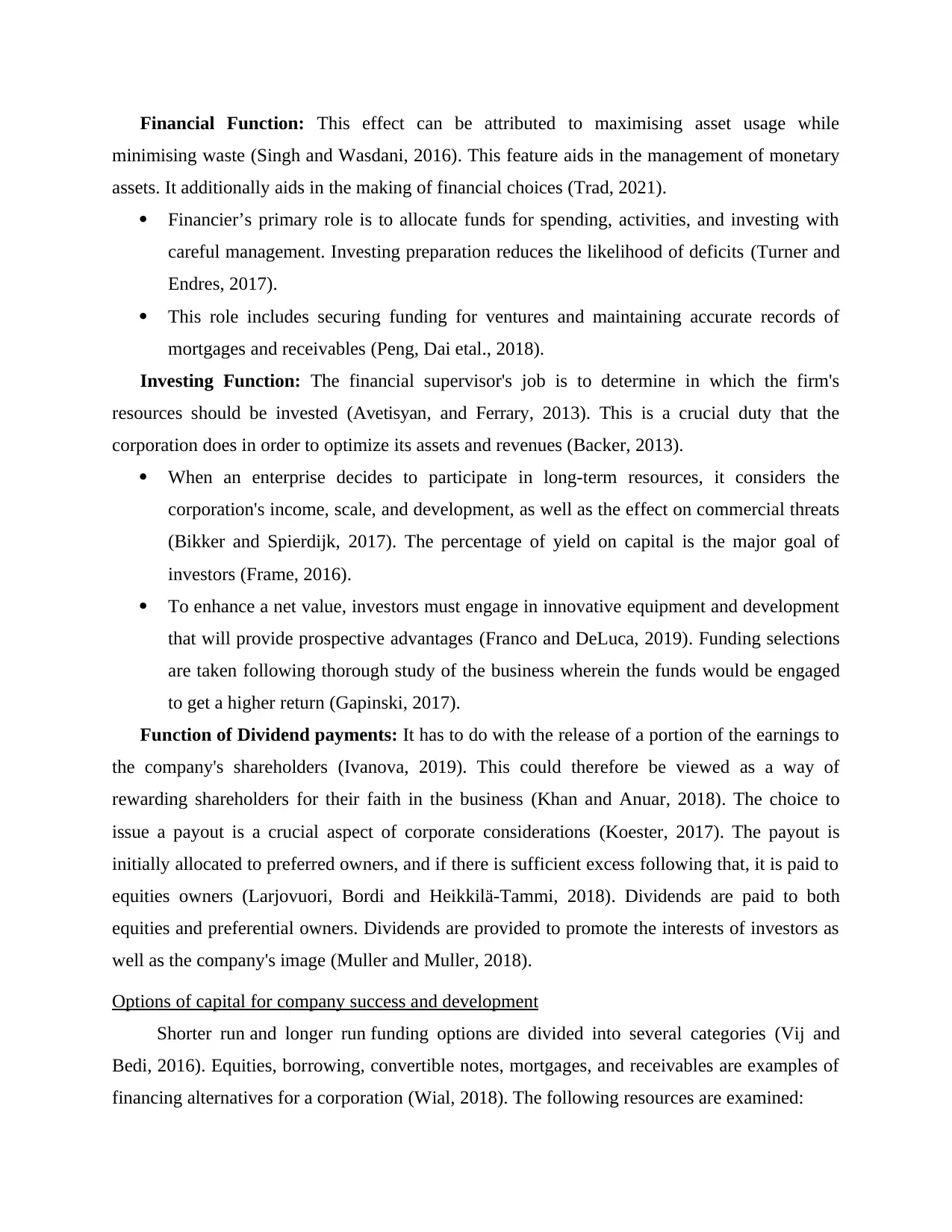
Financial Function: This effect can be attributed to maximising asset usage while
minimising waste (Singh and Wasdani, 2016). This feature aids in the management of monetary
assets. It additionally aids in the making of financial choices (Trad, 2021).
Financier’s primary role is to allocate funds for spending, activities, and investing with
careful management. Investing preparation reduces the likelihood of deficits (Turner and
Endres, 2017).
This role includes securing funding for ventures and maintaining accurate records of
mortgages and receivables (Peng, Dai etal., 2018).
Investing Function: The financial supervisor's job is to determine in which the firm's
resources should be invested (Avetisyan, and Ferrary, 2013). This is a crucial duty that the
corporation does in order to optimize its assets and revenues (Backer, 2013).
When an enterprise decides to participate in long-term resources, it considers the
corporation's income, scale, and development, as well as the effect on commercial threats
(Bikker and Spierdijk, 2017). The percentage of yield on capital is the major goal of
investors (Frame, 2016).
To enhance a net value, investors must engage in innovative equipment and development
that will provide prospective advantages (Franco and DeLuca, 2019). Funding selections
are taken following thorough study of the business wherein the funds would be engaged
to get a higher return (Gapinski, 2017).
Function of Dividend payments: It has to do with the release of a portion of the earnings to
the company's shareholders (Ivanova, 2019). This could therefore be viewed as a way of
rewarding shareholders for their faith in the business (Khan and Anuar, 2018). The choice to
issue a payout is a crucial aspect of corporate considerations (Koester, 2017). The payout is
initially allocated to preferred owners, and if there is sufficient excess following that, it is paid to
equities owners (Larjovuori, Bordi and Heikkilä-Tammi, 2018). Dividends are paid to both
equities and preferential owners. Dividends are provided to promote the interests of investors as
well as the company's image (Muller and Muller, 2018).
Options of capital for company success and development
Shorter run and longer run funding options are divided into several categories (Vij and
Bedi, 2016). Equities, borrowing, convertible notes, mortgages, and receivables are examples of
financing alternatives for a corporation (Wial, 2018). The following resources are examined:
minimising waste (Singh and Wasdani, 2016). This feature aids in the management of monetary
assets. It additionally aids in the making of financial choices (Trad, 2021).
Financier’s primary role is to allocate funds for spending, activities, and investing with
careful management. Investing preparation reduces the likelihood of deficits (Turner and
Endres, 2017).
This role includes securing funding for ventures and maintaining accurate records of
mortgages and receivables (Peng, Dai etal., 2018).
Investing Function: The financial supervisor's job is to determine in which the firm's
resources should be invested (Avetisyan, and Ferrary, 2013). This is a crucial duty that the
corporation does in order to optimize its assets and revenues (Backer, 2013).
When an enterprise decides to participate in long-term resources, it considers the
corporation's income, scale, and development, as well as the effect on commercial threats
(Bikker and Spierdijk, 2017). The percentage of yield on capital is the major goal of
investors (Frame, 2016).
To enhance a net value, investors must engage in innovative equipment and development
that will provide prospective advantages (Franco and DeLuca, 2019). Funding selections
are taken following thorough study of the business wherein the funds would be engaged
to get a higher return (Gapinski, 2017).
Function of Dividend payments: It has to do with the release of a portion of the earnings to
the company's shareholders (Ivanova, 2019). This could therefore be viewed as a way of
rewarding shareholders for their faith in the business (Khan and Anuar, 2018). The choice to
issue a payout is a crucial aspect of corporate considerations (Koester, 2017). The payout is
initially allocated to preferred owners, and if there is sufficient excess following that, it is paid to
equities owners (Larjovuori, Bordi and Heikkilä-Tammi, 2018). Dividends are paid to both
equities and preferential owners. Dividends are provided to promote the interests of investors as
well as the company's image (Muller and Muller, 2018).
Options of capital for company success and development
Shorter run and longer run funding options are divided into several categories (Vij and
Bedi, 2016). Equities, borrowing, convertible notes, mortgages, and receivables are examples of
financing alternatives for a corporation (Wial, 2018). The following resources are examined:
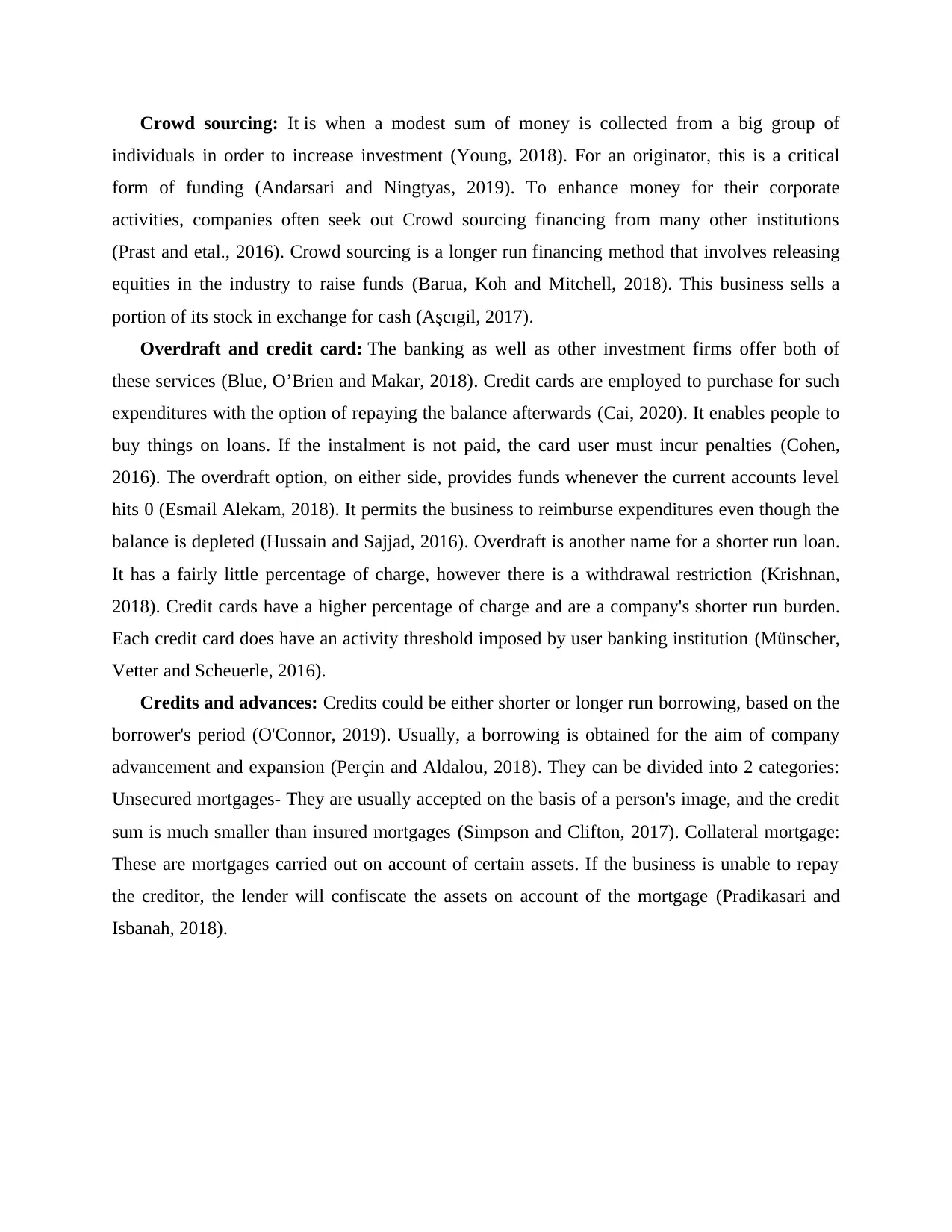
Crowd sourcing: It is when a modest sum of money is collected from a big group of
individuals in order to increase investment (Young, 2018). For an originator, this is a critical
form of funding (Andarsari and Ningtyas, 2019). To enhance money for their corporate
activities, companies often seek out Crowd sourcing financing from many other institutions
(Prast and etal., 2016). Crowd sourcing is a longer run financing method that involves releasing
equities in the industry to raise funds (Barua, Koh and Mitchell, 2018). This business sells a
portion of its stock in exchange for cash (Aşcıgil, 2017).
Overdraft and credit card: The banking as well as other investment firms offer both of
these services (Blue, O’Brien and Makar, 2018). Credit cards are employed to purchase for such
expenditures with the option of repaying the balance afterwards (Cai, 2020). It enables people to
buy things on loans. If the instalment is not paid, the card user must incur penalties (Cohen,
2016). The overdraft option, on either side, provides funds whenever the current accounts level
hits 0 (Esmail Alekam, 2018). It permits the business to reimburse expenditures even though the
balance is depleted (Hussain and Sajjad, 2016). Overdraft is another name for a shorter run loan.
It has a fairly little percentage of charge, however there is a withdrawal restriction (Krishnan,
2018). Credit cards have a higher percentage of charge and are a company's shorter run burden.
Each credit card does have an activity threshold imposed by user banking institution (Münscher,
Vetter and Scheuerle, 2016).
Credits and advances: Credits could be either shorter or longer run borrowing, based on the
borrower's period (O'Connor, 2019). Usually, a borrowing is obtained for the aim of company
advancement and expansion (Perçin and Aldalou, 2018). They can be divided into 2 categories:
Unsecured mortgages- They are usually accepted on the basis of a person's image, and the credit
sum is much smaller than insured mortgages (Simpson and Clifton, 2017). Collateral mortgage:
These are mortgages carried out on account of certain assets. If the business is unable to repay
the creditor, the lender will confiscate the assets on account of the mortgage (Pradikasari and
Isbanah, 2018).
individuals in order to increase investment (Young, 2018). For an originator, this is a critical
form of funding (Andarsari and Ningtyas, 2019). To enhance money for their corporate
activities, companies often seek out Crowd sourcing financing from many other institutions
(Prast and etal., 2016). Crowd sourcing is a longer run financing method that involves releasing
equities in the industry to raise funds (Barua, Koh and Mitchell, 2018). This business sells a
portion of its stock in exchange for cash (Aşcıgil, 2017).
Overdraft and credit card: The banking as well as other investment firms offer both of
these services (Blue, O’Brien and Makar, 2018). Credit cards are employed to purchase for such
expenditures with the option of repaying the balance afterwards (Cai, 2020). It enables people to
buy things on loans. If the instalment is not paid, the card user must incur penalties (Cohen,
2016). The overdraft option, on either side, provides funds whenever the current accounts level
hits 0 (Esmail Alekam, 2018). It permits the business to reimburse expenditures even though the
balance is depleted (Hussain and Sajjad, 2016). Overdraft is another name for a shorter run loan.
It has a fairly little percentage of charge, however there is a withdrawal restriction (Krishnan,
2018). Credit cards have a higher percentage of charge and are a company's shorter run burden.
Each credit card does have an activity threshold imposed by user banking institution (Münscher,
Vetter and Scheuerle, 2016).
Credits and advances: Credits could be either shorter or longer run borrowing, based on the
borrower's period (O'Connor, 2019). Usually, a borrowing is obtained for the aim of company
advancement and expansion (Perçin and Aldalou, 2018). They can be divided into 2 categories:
Unsecured mortgages- They are usually accepted on the basis of a person's image, and the credit
sum is much smaller than insured mortgages (Simpson and Clifton, 2017). Collateral mortgage:
These are mortgages carried out on account of certain assets. If the business is unable to repay
the creditor, the lender will confiscate the assets on account of the mortgage (Pradikasari and
Isbanah, 2018).
Paraphrase This Document
Need a fresh take? Get an instant paraphrase of this document with our AI Paraphraser
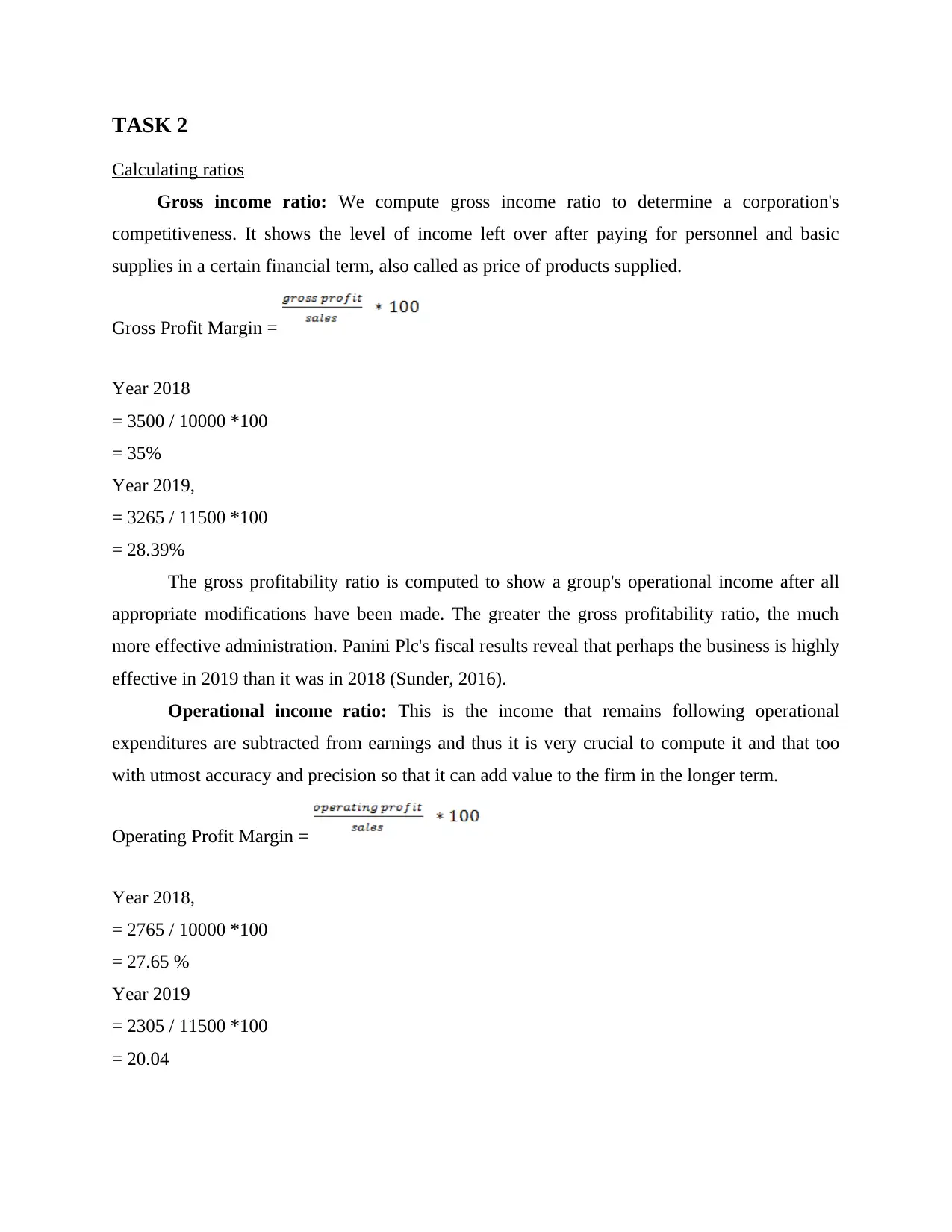
TASK 2
Calculating ratios
Gross income ratio: We compute gross income ratio to determine a corporation's
competitiveness. It shows the level of income left over after paying for personnel and basic
supplies in a certain financial term, also called as price of products supplied.
Gross Profit Margin =
Year 2018
= 3500 / 10000 *100
= 35%
Year 2019,
= 3265 / 11500 *100
= 28.39%
The gross profitability ratio is computed to show a group's operational income after all
appropriate modifications have been made. The greater the gross profitability ratio, the much
more effective administration. Panini Plc's fiscal results reveal that perhaps the business is highly
effective in 2019 than it was in 2018 (Sunder, 2016).
Operational income ratio: This is the income that remains following operational
expenditures are subtracted from earnings and thus it is very crucial to compute it and that too
with utmost accuracy and precision so that it can add value to the firm in the longer term.
Operating Profit Margin =
Year 2018,
= 2765 / 10000 *100
= 27.65 %
Year 2019
= 2305 / 11500 *100
= 20.04
Calculating ratios
Gross income ratio: We compute gross income ratio to determine a corporation's
competitiveness. It shows the level of income left over after paying for personnel and basic
supplies in a certain financial term, also called as price of products supplied.
Gross Profit Margin =
Year 2018
= 3500 / 10000 *100
= 35%
Year 2019,
= 3265 / 11500 *100
= 28.39%
The gross profitability ratio is computed to show a group's operational income after all
appropriate modifications have been made. The greater the gross profitability ratio, the much
more effective administration. Panini Plc's fiscal results reveal that perhaps the business is highly
effective in 2019 than it was in 2018 (Sunder, 2016).
Operational income ratio: This is the income that remains following operational
expenditures are subtracted from earnings and thus it is very crucial to compute it and that too
with utmost accuracy and precision so that it can add value to the firm in the longer term.
Operating Profit Margin =
Year 2018,
= 2765 / 10000 *100
= 27.65 %
Year 2019
= 2305 / 11500 *100
= 20.04
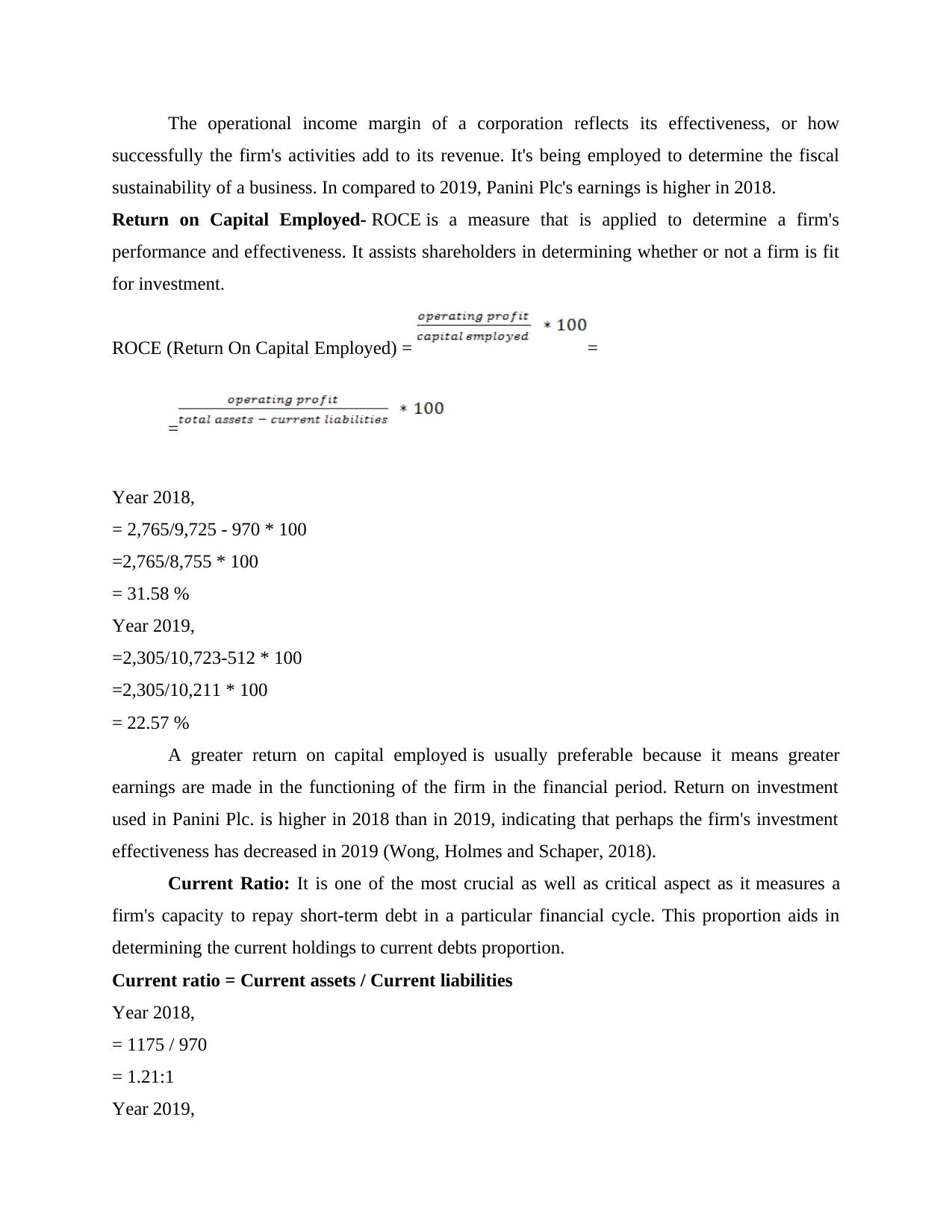
The operational income margin of a corporation reflects its effectiveness, or how
successfully the firm's activities add to its revenue. It's being employed to determine the fiscal
sustainability of a business. In compared to 2019, Panini Plc's earnings is higher in 2018.
Return on Capital Employed- ROCE is a measure that is applied to determine a firm's
performance and effectiveness. It assists shareholders in determining whether or not a firm is fit
for investment.
ROCE (Return On Capital Employed) = =
=
Year 2018,
= 2,765/9,725 - 970 * 100
=2,765/8,755 * 100
= 31.58 %
Year 2019,
=2,305/10,723-512 * 100
=2,305/10,211 * 100
= 22.57 %
A greater return on capital employed is usually preferable because it means greater
earnings are made in the functioning of the firm in the financial period. Return on investment
used in Panini Plc. is higher in 2018 than in 2019, indicating that perhaps the firm's investment
effectiveness has decreased in 2019 (Wong, Holmes and Schaper, 2018).
Current Ratio: It is one of the most crucial as well as critical aspect as it measures a
firm's capacity to repay short-term debt in a particular financial cycle. This proportion aids in
determining the current holdings to current debts proportion.
Current ratio = Current assets / Current liabilities
Year 2018,
= 1175 / 970
= 1.21:1
Year 2019,
successfully the firm's activities add to its revenue. It's being employed to determine the fiscal
sustainability of a business. In compared to 2019, Panini Plc's earnings is higher in 2018.
Return on Capital Employed- ROCE is a measure that is applied to determine a firm's
performance and effectiveness. It assists shareholders in determining whether or not a firm is fit
for investment.
ROCE (Return On Capital Employed) = =
=
Year 2018,
= 2,765/9,725 - 970 * 100
=2,765/8,755 * 100
= 31.58 %
Year 2019,
=2,305/10,723-512 * 100
=2,305/10,211 * 100
= 22.57 %
A greater return on capital employed is usually preferable because it means greater
earnings are made in the functioning of the firm in the financial period. Return on investment
used in Panini Plc. is higher in 2018 than in 2019, indicating that perhaps the firm's investment
effectiveness has decreased in 2019 (Wong, Holmes and Schaper, 2018).
Current Ratio: It is one of the most crucial as well as critical aspect as it measures a
firm's capacity to repay short-term debt in a particular financial cycle. This proportion aids in
determining the current holdings to current debts proportion.
Current ratio = Current assets / Current liabilities
Year 2018,
= 1175 / 970
= 1.21:1
Year 2019,
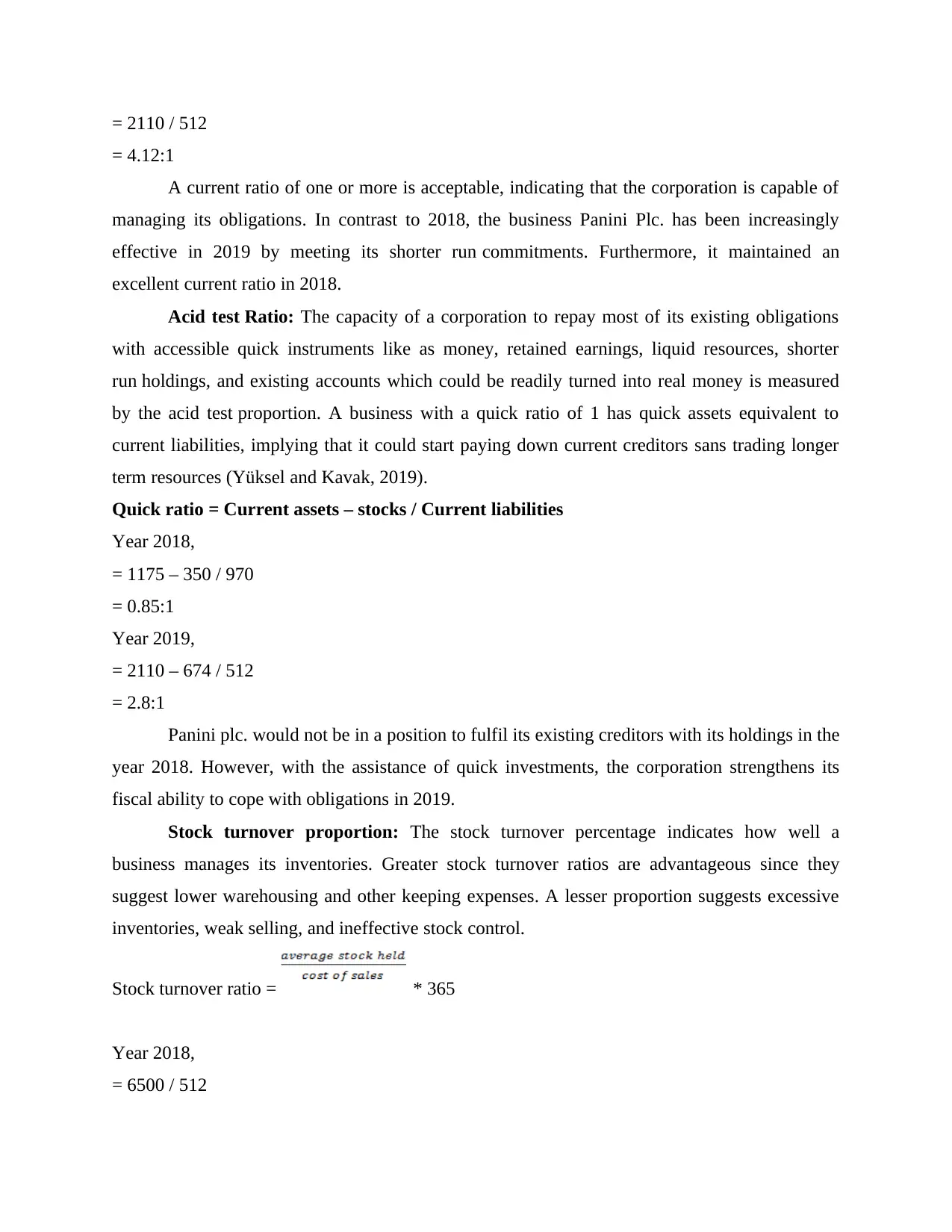
= 2110 / 512
= 4.12:1
A current ratio of one or more is acceptable, indicating that the corporation is capable of
managing its obligations. In contrast to 2018, the business Panini Plc. has been increasingly
effective in 2019 by meeting its shorter run commitments. Furthermore, it maintained an
excellent current ratio in 2018.
Acid test Ratio: The capacity of a corporation to repay most of its existing obligations
with accessible quick instruments like as money, retained earnings, liquid resources, shorter
run holdings, and existing accounts which could be readily turned into real money is measured
by the acid test proportion. A business with a quick ratio of 1 has quick assets equivalent to
current liabilities, implying that it could start paying down current creditors sans trading longer
term resources (Yüksel and Kavak, 2019).
Quick ratio = Current assets – stocks / Current liabilities
Year 2018,
= 1175 – 350 / 970
= 0.85:1
Year 2019,
= 2110 – 674 / 512
= 2.8:1
Panini plc. would not be in a position to fulfil its existing creditors with its holdings in the
year 2018. However, with the assistance of quick investments, the corporation strengthens its
fiscal ability to cope with obligations in 2019.
Stock turnover proportion: The stock turnover percentage indicates how well a
business manages its inventories. Greater stock turnover ratios are advantageous since they
suggest lower warehousing and other keeping expenses. A lesser proportion suggests excessive
inventories, weak selling, and ineffective stock control.
Stock turnover ratio = * 365
Year 2018,
= 6500 / 512
= 4.12:1
A current ratio of one or more is acceptable, indicating that the corporation is capable of
managing its obligations. In contrast to 2018, the business Panini Plc. has been increasingly
effective in 2019 by meeting its shorter run commitments. Furthermore, it maintained an
excellent current ratio in 2018.
Acid test Ratio: The capacity of a corporation to repay most of its existing obligations
with accessible quick instruments like as money, retained earnings, liquid resources, shorter
run holdings, and existing accounts which could be readily turned into real money is measured
by the acid test proportion. A business with a quick ratio of 1 has quick assets equivalent to
current liabilities, implying that it could start paying down current creditors sans trading longer
term resources (Yüksel and Kavak, 2019).
Quick ratio = Current assets – stocks / Current liabilities
Year 2018,
= 1175 – 350 / 970
= 0.85:1
Year 2019,
= 2110 – 674 / 512
= 2.8:1
Panini plc. would not be in a position to fulfil its existing creditors with its holdings in the
year 2018. However, with the assistance of quick investments, the corporation strengthens its
fiscal ability to cope with obligations in 2019.
Stock turnover proportion: The stock turnover percentage indicates how well a
business manages its inventories. Greater stock turnover ratios are advantageous since they
suggest lower warehousing and other keeping expenses. A lesser proportion suggests excessive
inventories, weak selling, and ineffective stock control.
Stock turnover ratio = * 365
Year 2018,
= 6500 / 512
Secure Best Marks with AI Grader
Need help grading? Try our AI Grader for instant feedback on your assignments.
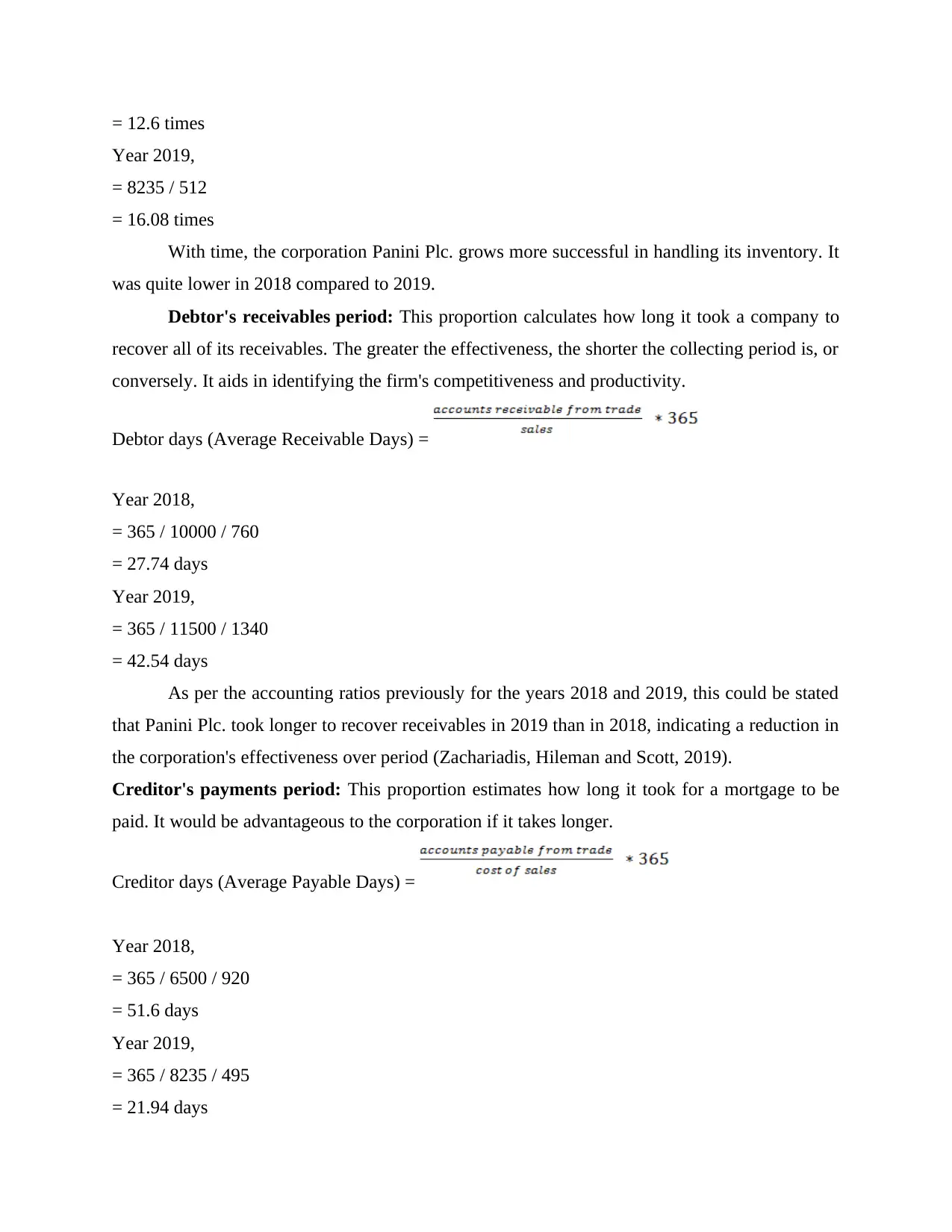
= 12.6 times
Year 2019,
= 8235 / 512
= 16.08 times
With time, the corporation Panini Plc. grows more successful in handling its inventory. It
was quite lower in 2018 compared to 2019.
Debtor's receivables period: This proportion calculates how long it took a company to
recover all of its receivables. The greater the effectiveness, the shorter the collecting period is, or
conversely. It aids in identifying the firm's competitiveness and productivity.
Debtor days (Average Receivable Days) =
Year 2018,
= 365 / 10000 / 760
= 27.74 days
Year 2019,
= 365 / 11500 / 1340
= 42.54 days
As per the accounting ratios previously for the years 2018 and 2019, this could be stated
that Panini Plc. took longer to recover receivables in 2019 than in 2018, indicating a reduction in
the corporation's effectiveness over period (Zachariadis, Hileman and Scott, 2019).
Creditor's payments period: This proportion estimates how long it took for a mortgage to be
paid. It would be advantageous to the corporation if it takes longer.
Creditor days (Average Payable Days) =
Year 2018,
= 365 / 6500 / 920
= 51.6 days
Year 2019,
= 365 / 8235 / 495
= 21.94 days
Year 2019,
= 8235 / 512
= 16.08 times
With time, the corporation Panini Plc. grows more successful in handling its inventory. It
was quite lower in 2018 compared to 2019.
Debtor's receivables period: This proportion calculates how long it took a company to
recover all of its receivables. The greater the effectiveness, the shorter the collecting period is, or
conversely. It aids in identifying the firm's competitiveness and productivity.
Debtor days (Average Receivable Days) =
Year 2018,
= 365 / 10000 / 760
= 27.74 days
Year 2019,
= 365 / 11500 / 1340
= 42.54 days
As per the accounting ratios previously for the years 2018 and 2019, this could be stated
that Panini Plc. took longer to recover receivables in 2019 than in 2018, indicating a reduction in
the corporation's effectiveness over period (Zachariadis, Hileman and Scott, 2019).
Creditor's payments period: This proportion estimates how long it took for a mortgage to be
paid. It would be advantageous to the corporation if it takes longer.
Creditor days (Average Payable Days) =
Year 2018,
= 365 / 6500 / 920
= 51.6 days
Year 2019,
= 365 / 8235 / 495
= 21.94 days
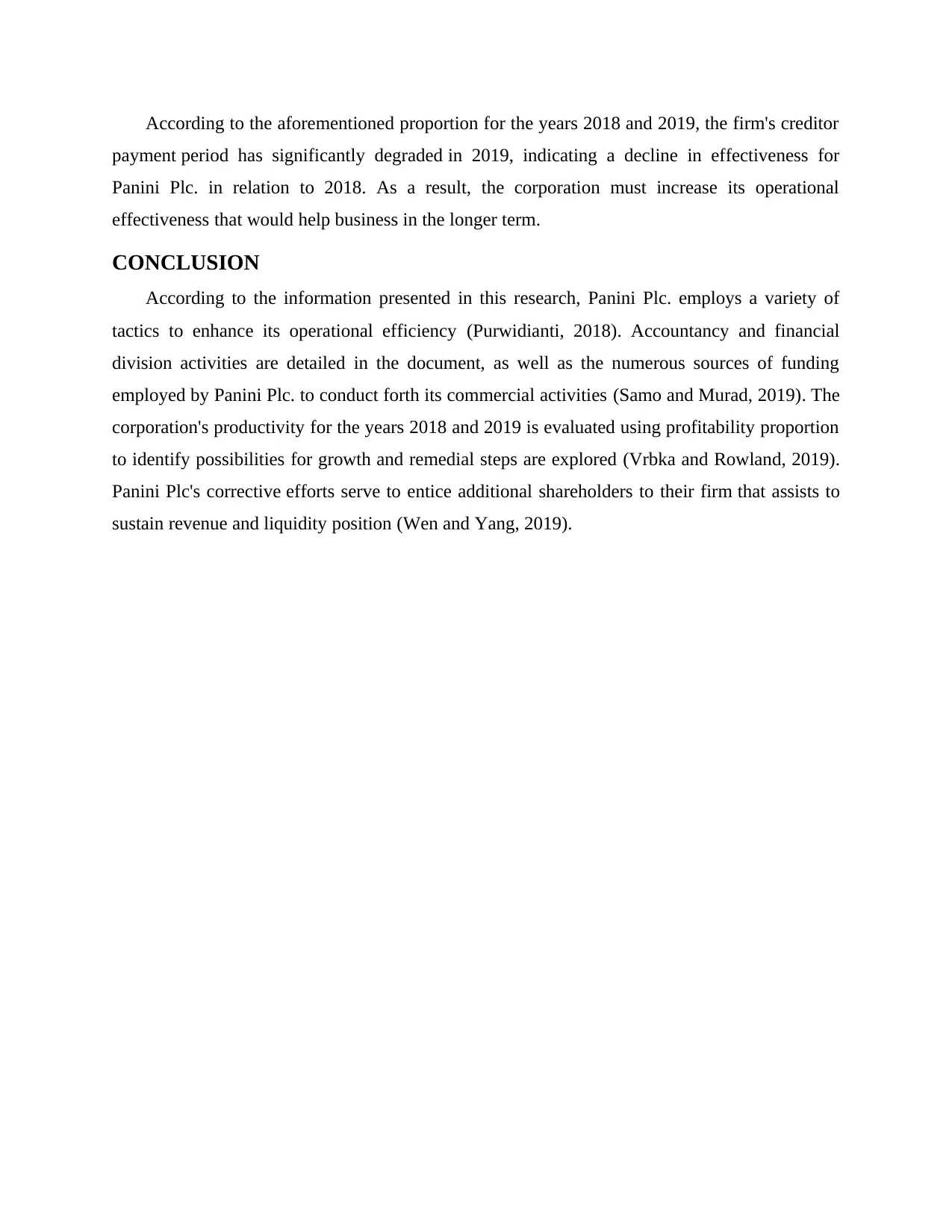
According to the aforementioned proportion for the years 2018 and 2019, the firm's creditor
payment period has significantly degraded in 2019, indicating a decline in effectiveness for
Panini Plc. in relation to 2018. As a result, the corporation must increase its operational
effectiveness that would help business in the longer term.
CONCLUSION
According to the information presented in this research, Panini Plc. employs a variety of
tactics to enhance its operational efficiency (Purwidianti, 2018). Accountancy and financial
division activities are detailed in the document, as well as the numerous sources of funding
employed by Panini Plc. to conduct forth its commercial activities (Samo and Murad, 2019). The
corporation's productivity for the years 2018 and 2019 is evaluated using profitability proportion
to identify possibilities for growth and remedial steps are explored (Vrbka and Rowland, 2019).
Panini Plc's corrective efforts serve to entice additional shareholders to their firm that assists to
sustain revenue and liquidity position (Wen and Yang, 2019).
payment period has significantly degraded in 2019, indicating a decline in effectiveness for
Panini Plc. in relation to 2018. As a result, the corporation must increase its operational
effectiveness that would help business in the longer term.
CONCLUSION
According to the information presented in this research, Panini Plc. employs a variety of
tactics to enhance its operational efficiency (Purwidianti, 2018). Accountancy and financial
division activities are detailed in the document, as well as the numerous sources of funding
employed by Panini Plc. to conduct forth its commercial activities (Samo and Murad, 2019). The
corporation's productivity for the years 2018 and 2019 is evaluated using profitability proportion
to identify possibilities for growth and remedial steps are explored (Vrbka and Rowland, 2019).
Panini Plc's corrective efforts serve to entice additional shareholders to their firm that assists to
sustain revenue and liquidity position (Wen and Yang, 2019).
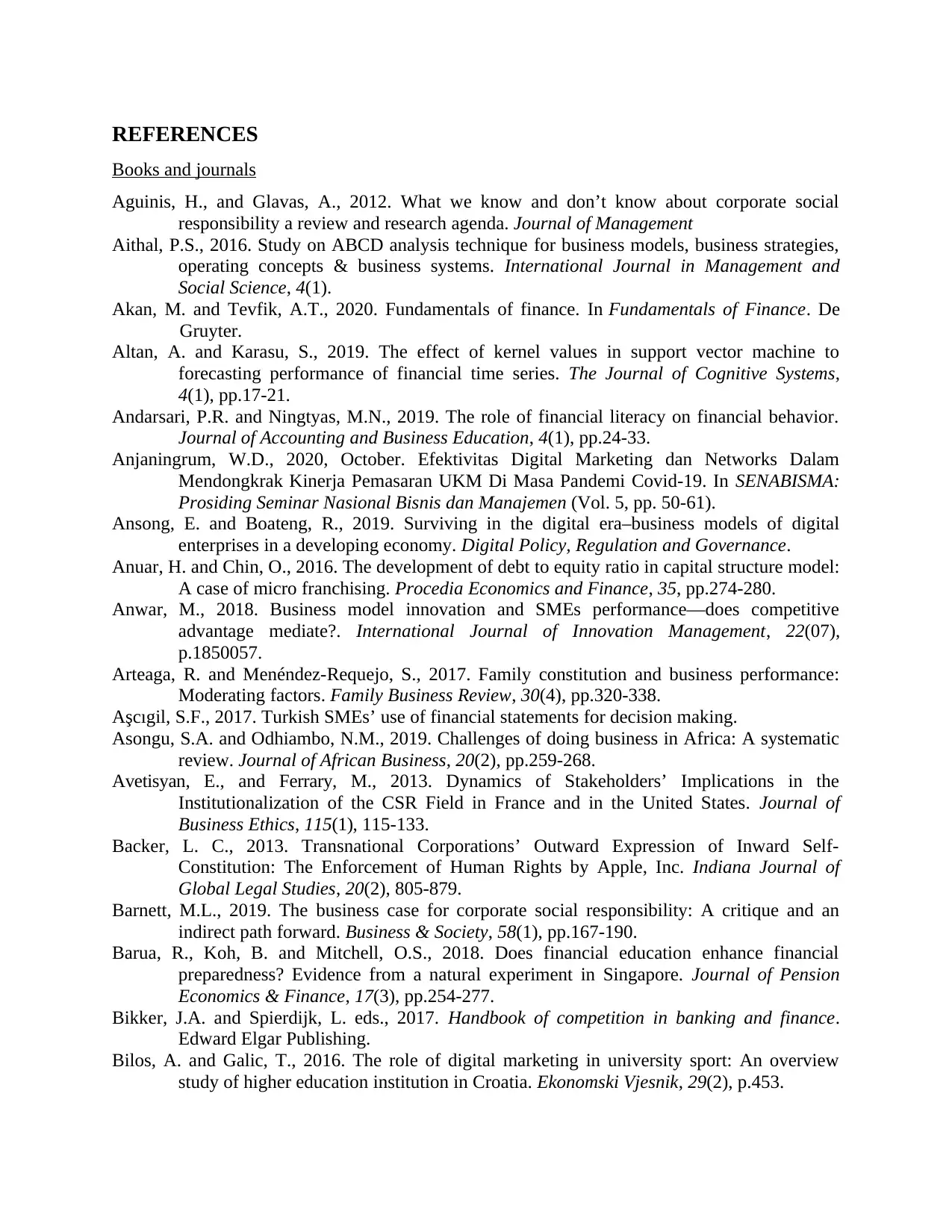
REFERENCES
Books and journals
Aguinis, H., and Glavas, A., 2012. What we know and don’t know about corporate social
responsibility a review and research agenda. Journal of Management
Aithal, P.S., 2016. Study on ABCD analysis technique for business models, business strategies,
operating concepts & business systems. International Journal in Management and
Social Science, 4(1).
Akan, M. and Tevfik, A.T., 2020. Fundamentals of finance. In Fundamentals of Finance. De
Gruyter.
Altan, A. and Karasu, S., 2019. The effect of kernel values in support vector machine to
forecasting performance of financial time series. The Journal of Cognitive Systems,
4(1), pp.17-21.
Andarsari, P.R. and Ningtyas, M.N., 2019. The role of financial literacy on financial behavior.
Journal of Accounting and Business Education, 4(1), pp.24-33.
Anjaningrum, W.D., 2020, October. Efektivitas Digital Marketing dan Networks Dalam
Mendongkrak Kinerja Pemasaran UKM Di Masa Pandemi Covid-19. In SENABISMA:
Prosiding Seminar Nasional Bisnis dan Manajemen (Vol. 5, pp. 50-61).
Ansong, E. and Boateng, R., 2019. Surviving in the digital era–business models of digital
enterprises in a developing economy. Digital Policy, Regulation and Governance.
Anuar, H. and Chin, O., 2016. The development of debt to equity ratio in capital structure model:
A case of micro franchising. Procedia Economics and Finance, 35, pp.274-280.
Anwar, M., 2018. Business model innovation and SMEs performance—does competitive
advantage mediate?. International Journal of Innovation Management, 22(07),
p.1850057.
Arteaga, R. and Menéndez-Requejo, S., 2017. Family constitution and business performance:
Moderating factors. Family Business Review, 30(4), pp.320-338.
Aşcıgil, S.F., 2017. Turkish SMEs’ use of financial statements for decision making.
Asongu, S.A. and Odhiambo, N.M., 2019. Challenges of doing business in Africa: A systematic
review. Journal of African Business, 20(2), pp.259-268.
Avetisyan, E., and Ferrary, M., 2013. Dynamics of Stakeholders’ Implications in the
Institutionalization of the CSR Field in France and in the United States. Journal of
Business Ethics, 115(1), 115-133.
Backer, L. C., 2013. Transnational Corporations’ Outward Expression of Inward Self-
Constitution: The Enforcement of Human Rights by Apple, Inc. Indiana Journal of
Global Legal Studies, 20(2), 805-879.
Barnett, M.L., 2019. The business case for corporate social responsibility: A critique and an
indirect path forward. Business & Society, 58(1), pp.167-190.
Barua, R., Koh, B. and Mitchell, O.S., 2018. Does financial education enhance financial
preparedness? Evidence from a natural experiment in Singapore. Journal of Pension
Economics & Finance, 17(3), pp.254-277.
Bikker, J.A. and Spierdijk, L. eds., 2017. Handbook of competition in banking and finance.
Edward Elgar Publishing.
Bilos, A. and Galic, T., 2016. The role of digital marketing in university sport: An overview
study of higher education institution in Croatia. Ekonomski Vjesnik, 29(2), p.453.
Books and journals
Aguinis, H., and Glavas, A., 2012. What we know and don’t know about corporate social
responsibility a review and research agenda. Journal of Management
Aithal, P.S., 2016. Study on ABCD analysis technique for business models, business strategies,
operating concepts & business systems. International Journal in Management and
Social Science, 4(1).
Akan, M. and Tevfik, A.T., 2020. Fundamentals of finance. In Fundamentals of Finance. De
Gruyter.
Altan, A. and Karasu, S., 2019. The effect of kernel values in support vector machine to
forecasting performance of financial time series. The Journal of Cognitive Systems,
4(1), pp.17-21.
Andarsari, P.R. and Ningtyas, M.N., 2019. The role of financial literacy on financial behavior.
Journal of Accounting and Business Education, 4(1), pp.24-33.
Anjaningrum, W.D., 2020, October. Efektivitas Digital Marketing dan Networks Dalam
Mendongkrak Kinerja Pemasaran UKM Di Masa Pandemi Covid-19. In SENABISMA:
Prosiding Seminar Nasional Bisnis dan Manajemen (Vol. 5, pp. 50-61).
Ansong, E. and Boateng, R., 2019. Surviving in the digital era–business models of digital
enterprises in a developing economy. Digital Policy, Regulation and Governance.
Anuar, H. and Chin, O., 2016. The development of debt to equity ratio in capital structure model:
A case of micro franchising. Procedia Economics and Finance, 35, pp.274-280.
Anwar, M., 2018. Business model innovation and SMEs performance—does competitive
advantage mediate?. International Journal of Innovation Management, 22(07),
p.1850057.
Arteaga, R. and Menéndez-Requejo, S., 2017. Family constitution and business performance:
Moderating factors. Family Business Review, 30(4), pp.320-338.
Aşcıgil, S.F., 2017. Turkish SMEs’ use of financial statements for decision making.
Asongu, S.A. and Odhiambo, N.M., 2019. Challenges of doing business in Africa: A systematic
review. Journal of African Business, 20(2), pp.259-268.
Avetisyan, E., and Ferrary, M., 2013. Dynamics of Stakeholders’ Implications in the
Institutionalization of the CSR Field in France and in the United States. Journal of
Business Ethics, 115(1), 115-133.
Backer, L. C., 2013. Transnational Corporations’ Outward Expression of Inward Self-
Constitution: The Enforcement of Human Rights by Apple, Inc. Indiana Journal of
Global Legal Studies, 20(2), 805-879.
Barnett, M.L., 2019. The business case for corporate social responsibility: A critique and an
indirect path forward. Business & Society, 58(1), pp.167-190.
Barua, R., Koh, B. and Mitchell, O.S., 2018. Does financial education enhance financial
preparedness? Evidence from a natural experiment in Singapore. Journal of Pension
Economics & Finance, 17(3), pp.254-277.
Bikker, J.A. and Spierdijk, L. eds., 2017. Handbook of competition in banking and finance.
Edward Elgar Publishing.
Bilos, A. and Galic, T., 2016. The role of digital marketing in university sport: An overview
study of higher education institution in Croatia. Ekonomski Vjesnik, 29(2), p.453.
Paraphrase This Document
Need a fresh take? Get an instant paraphrase of this document with our AI Paraphraser
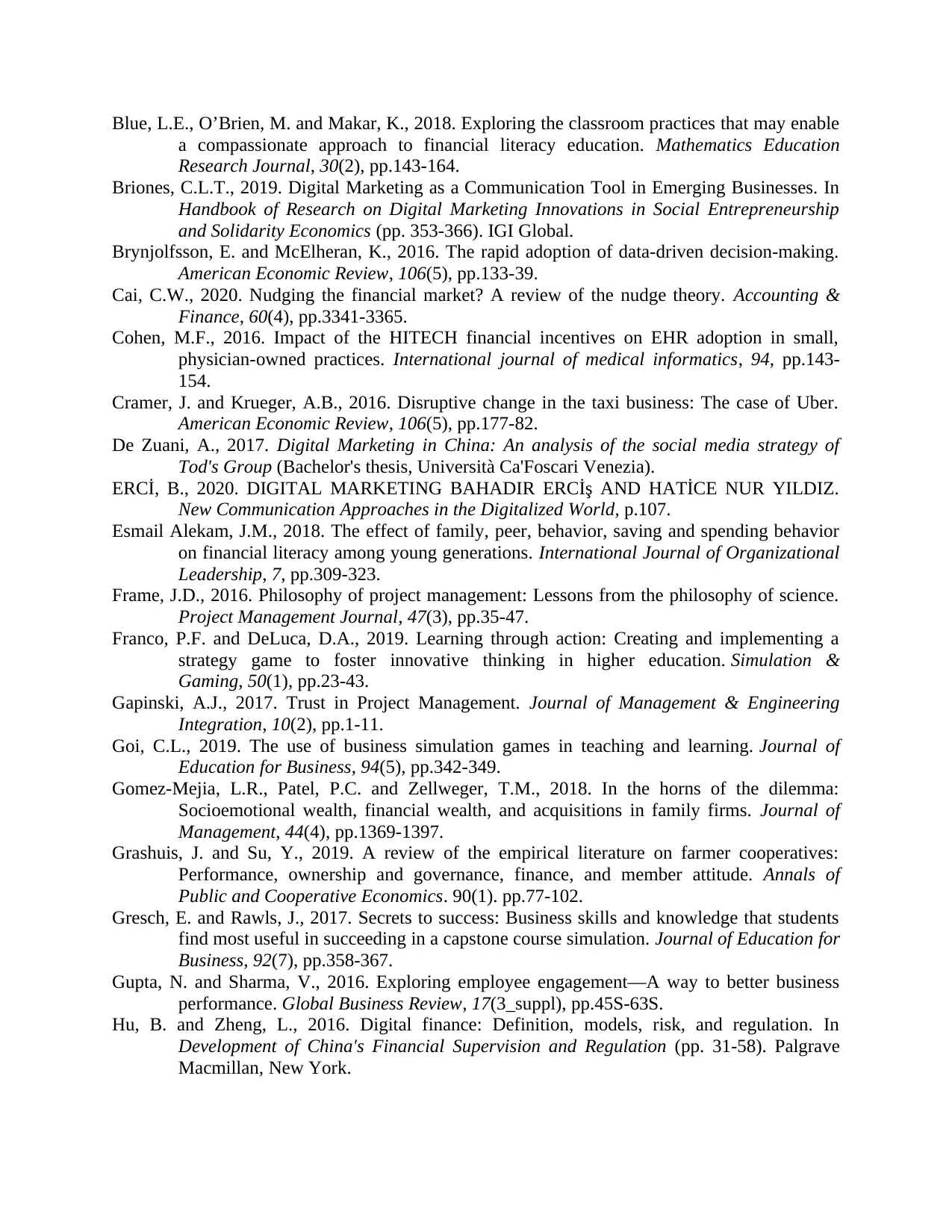
Blue, L.E., O’Brien, M. and Makar, K., 2018. Exploring the classroom practices that may enable
a compassionate approach to financial literacy education. Mathematics Education
Research Journal, 30(2), pp.143-164.
Briones, C.L.T., 2019. Digital Marketing as a Communication Tool in Emerging Businesses. In
Handbook of Research on Digital Marketing Innovations in Social Entrepreneurship
and Solidarity Economics (pp. 353-366). IGI Global.
Brynjolfsson, E. and McElheran, K., 2016. The rapid adoption of data-driven decision-making.
American Economic Review, 106(5), pp.133-39.
Cai, C.W., 2020. Nudging the financial market? A review of the nudge theory. Accounting &
Finance, 60(4), pp.3341-3365.
Cohen, M.F., 2016. Impact of the HITECH financial incentives on EHR adoption in small,
physician-owned practices. International journal of medical informatics, 94, pp.143-
154.
Cramer, J. and Krueger, A.B., 2016. Disruptive change in the taxi business: The case of Uber.
American Economic Review, 106(5), pp.177-82.
De Zuani, A., 2017. Digital Marketing in China: An analysis of the social media strategy of
Tod's Group (Bachelor's thesis, Università Ca'Foscari Venezia).
ERCİ, B., 2020. DIGITAL MARKETING BAHADIR ERCİş AND HATİCE NUR YILDIZ.
New Communication Approaches in the Digitalized World, p.107.
Esmail Alekam, J.M., 2018. The effect of family, peer, behavior, saving and spending behavior
on financial literacy among young generations. International Journal of Organizational
Leadership, 7, pp.309-323.
Frame, J.D., 2016. Philosophy of project management: Lessons from the philosophy of science.
Project Management Journal, 47(3), pp.35-47.
Franco, P.F. and DeLuca, D.A., 2019. Learning through action: Creating and implementing a
strategy game to foster innovative thinking in higher education. Simulation &
Gaming, 50(1), pp.23-43.
Gapinski, A.J., 2017. Trust in Project Management. Journal of Management & Engineering
Integration, 10(2), pp.1-11.
Goi, C.L., 2019. The use of business simulation games in teaching and learning. Journal of
Education for Business, 94(5), pp.342-349.
Gomez-Mejia, L.R., Patel, P.C. and Zellweger, T.M., 2018. In the horns of the dilemma:
Socioemotional wealth, financial wealth, and acquisitions in family firms. Journal of
Management, 44(4), pp.1369-1397.
Grashuis, J. and Su, Y., 2019. A review of the empirical literature on farmer cooperatives:
Performance, ownership and governance, finance, and member attitude. Annals of
Public and Cooperative Economics. 90(1). pp.77-102.
Gresch, E. and Rawls, J., 2017. Secrets to success: Business skills and knowledge that students
find most useful in succeeding in a capstone course simulation. Journal of Education for
Business, 92(7), pp.358-367.
Gupta, N. and Sharma, V., 2016. Exploring employee engagement—A way to better business
performance. Global Business Review, 17(3_suppl), pp.45S-63S.
Hu, B. and Zheng, L., 2016. Digital finance: Definition, models, risk, and regulation. In
Development of China's Financial Supervision and Regulation (pp. 31-58). Palgrave
Macmillan, New York.
a compassionate approach to financial literacy education. Mathematics Education
Research Journal, 30(2), pp.143-164.
Briones, C.L.T., 2019. Digital Marketing as a Communication Tool in Emerging Businesses. In
Handbook of Research on Digital Marketing Innovations in Social Entrepreneurship
and Solidarity Economics (pp. 353-366). IGI Global.
Brynjolfsson, E. and McElheran, K., 2016. The rapid adoption of data-driven decision-making.
American Economic Review, 106(5), pp.133-39.
Cai, C.W., 2020. Nudging the financial market? A review of the nudge theory. Accounting &
Finance, 60(4), pp.3341-3365.
Cohen, M.F., 2016. Impact of the HITECH financial incentives on EHR adoption in small,
physician-owned practices. International journal of medical informatics, 94, pp.143-
154.
Cramer, J. and Krueger, A.B., 2016. Disruptive change in the taxi business: The case of Uber.
American Economic Review, 106(5), pp.177-82.
De Zuani, A., 2017. Digital Marketing in China: An analysis of the social media strategy of
Tod's Group (Bachelor's thesis, Università Ca'Foscari Venezia).
ERCİ, B., 2020. DIGITAL MARKETING BAHADIR ERCİş AND HATİCE NUR YILDIZ.
New Communication Approaches in the Digitalized World, p.107.
Esmail Alekam, J.M., 2018. The effect of family, peer, behavior, saving and spending behavior
on financial literacy among young generations. International Journal of Organizational
Leadership, 7, pp.309-323.
Frame, J.D., 2016. Philosophy of project management: Lessons from the philosophy of science.
Project Management Journal, 47(3), pp.35-47.
Franco, P.F. and DeLuca, D.A., 2019. Learning through action: Creating and implementing a
strategy game to foster innovative thinking in higher education. Simulation &
Gaming, 50(1), pp.23-43.
Gapinski, A.J., 2017. Trust in Project Management. Journal of Management & Engineering
Integration, 10(2), pp.1-11.
Goi, C.L., 2019. The use of business simulation games in teaching and learning. Journal of
Education for Business, 94(5), pp.342-349.
Gomez-Mejia, L.R., Patel, P.C. and Zellweger, T.M., 2018. In the horns of the dilemma:
Socioemotional wealth, financial wealth, and acquisitions in family firms. Journal of
Management, 44(4), pp.1369-1397.
Grashuis, J. and Su, Y., 2019. A review of the empirical literature on farmer cooperatives:
Performance, ownership and governance, finance, and member attitude. Annals of
Public and Cooperative Economics. 90(1). pp.77-102.
Gresch, E. and Rawls, J., 2017. Secrets to success: Business skills and knowledge that students
find most useful in succeeding in a capstone course simulation. Journal of Education for
Business, 92(7), pp.358-367.
Gupta, N. and Sharma, V., 2016. Exploring employee engagement—A way to better business
performance. Global Business Review, 17(3_suppl), pp.45S-63S.
Hu, B. and Zheng, L., 2016. Digital finance: Definition, models, risk, and regulation. In
Development of China's Financial Supervision and Regulation (pp. 31-58). Palgrave
Macmillan, New York.
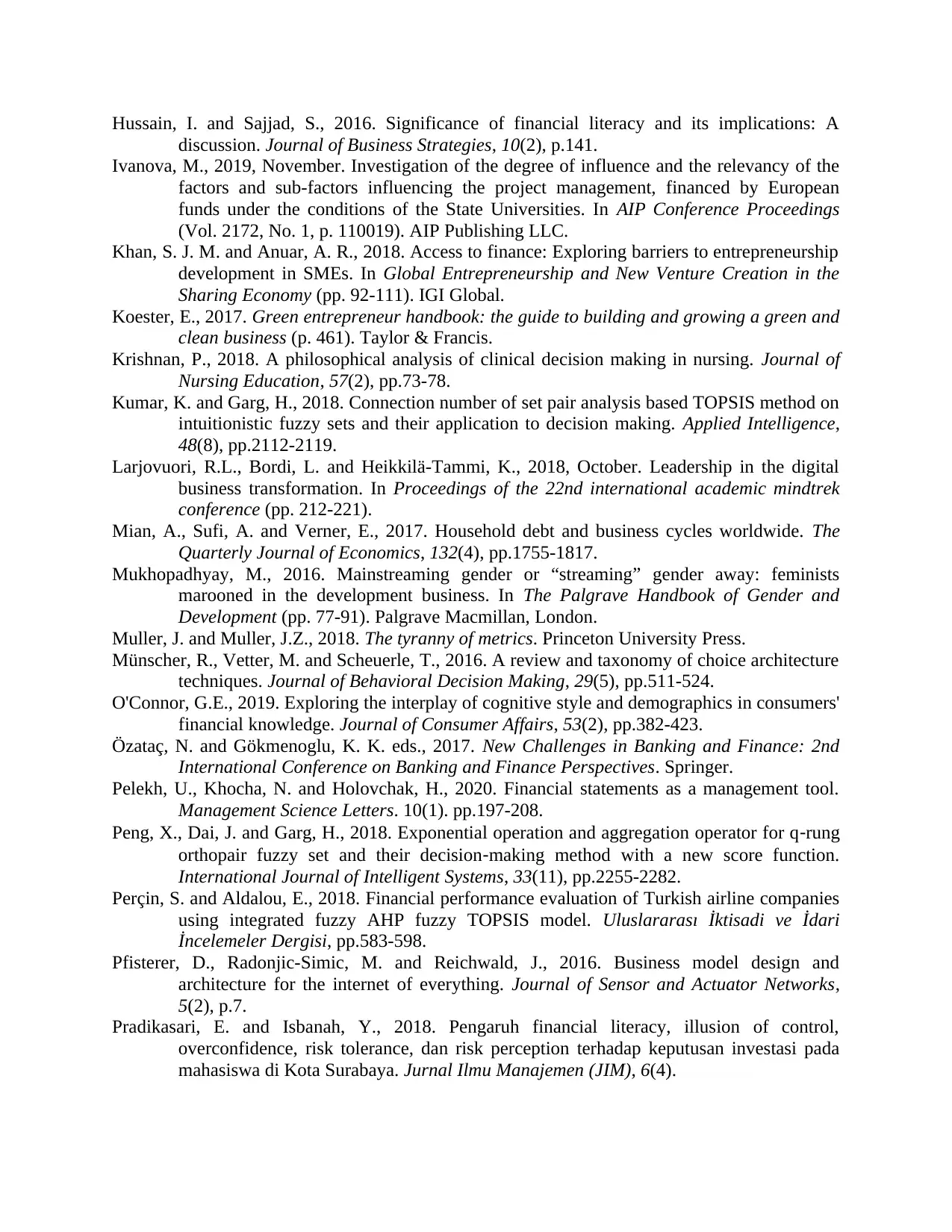
Hussain, I. and Sajjad, S., 2016. Significance of financial literacy and its implications: A
discussion. Journal of Business Strategies, 10(2), p.141.
Ivanova, M., 2019, November. Investigation of the degree of influence and the relevancy of the
factors and sub-factors influencing the project management, financed by European
funds under the conditions of the State Universities. In AIP Conference Proceedings
(Vol. 2172, No. 1, p. 110019). AIP Publishing LLC.
Khan, S. J. M. and Anuar, A. R., 2018. Access to finance: Exploring barriers to entrepreneurship
development in SMEs. In Global Entrepreneurship and New Venture Creation in the
Sharing Economy (pp. 92-111). IGI Global.
Koester, E., 2017. Green entrepreneur handbook: the guide to building and growing a green and
clean business (p. 461). Taylor & Francis.
Krishnan, P., 2018. A philosophical analysis of clinical decision making in nursing. Journal of
Nursing Education, 57(2), pp.73-78.
Kumar, K. and Garg, H., 2018. Connection number of set pair analysis based TOPSIS method on
intuitionistic fuzzy sets and their application to decision making. Applied Intelligence,
48(8), pp.2112-2119.
Larjovuori, R.L., Bordi, L. and Heikkilä-Tammi, K., 2018, October. Leadership in the digital
business transformation. In Proceedings of the 22nd international academic mindtrek
conference (pp. 212-221).
Mian, A., Sufi, A. and Verner, E., 2017. Household debt and business cycles worldwide. The
Quarterly Journal of Economics, 132(4), pp.1755-1817.
Mukhopadhyay, M., 2016. Mainstreaming gender or “streaming” gender away: feminists
marooned in the development business. In The Palgrave Handbook of Gender and
Development (pp. 77-91). Palgrave Macmillan, London.
Muller, J. and Muller, J.Z., 2018. The tyranny of metrics. Princeton University Press.
Münscher, R., Vetter, M. and Scheuerle, T., 2016. A review and taxonomy of choice architecture
techniques. Journal of Behavioral Decision Making, 29(5), pp.511-524.
O'Connor, G.E., 2019. Exploring the interplay of cognitive style and demographics in consumers'
financial knowledge. Journal of Consumer Affairs, 53(2), pp.382-423.
Özataç, N. and Gökmenoglu, K. K. eds., 2017. New Challenges in Banking and Finance: 2nd
International Conference on Banking and Finance Perspectives. Springer.
Pelekh, U., Khocha, N. and Holovchak, H., 2020. Financial statements as a management tool.
Management Science Letters. 10(1). pp.197-208.
Peng, X., Dai, J. and Garg, H., 2018. Exponential operation and aggregation operator for q‐rung
orthopair fuzzy set and their decision‐making method with a new score function.
International Journal of Intelligent Systems, 33(11), pp.2255-2282.
Perçin, S. and Aldalou, E., 2018. Financial performance evaluation of Turkish airline companies
using integrated fuzzy AHP fuzzy TOPSIS model. Uluslararası İktisadi ve İdari
İncelemeler Dergisi, pp.583-598.
Pfisterer, D., Radonjic-Simic, M. and Reichwald, J., 2016. Business model design and
architecture for the internet of everything. Journal of Sensor and Actuator Networks,
5(2), p.7.
Pradikasari, E. and Isbanah, Y., 2018. Pengaruh financial literacy, illusion of control,
overconfidence, risk tolerance, dan risk perception terhadap keputusan investasi pada
mahasiswa di Kota Surabaya. Jurnal Ilmu Manajemen (JIM), 6(4).
discussion. Journal of Business Strategies, 10(2), p.141.
Ivanova, M., 2019, November. Investigation of the degree of influence and the relevancy of the
factors and sub-factors influencing the project management, financed by European
funds under the conditions of the State Universities. In AIP Conference Proceedings
(Vol. 2172, No. 1, p. 110019). AIP Publishing LLC.
Khan, S. J. M. and Anuar, A. R., 2018. Access to finance: Exploring barriers to entrepreneurship
development in SMEs. In Global Entrepreneurship and New Venture Creation in the
Sharing Economy (pp. 92-111). IGI Global.
Koester, E., 2017. Green entrepreneur handbook: the guide to building and growing a green and
clean business (p. 461). Taylor & Francis.
Krishnan, P., 2018. A philosophical analysis of clinical decision making in nursing. Journal of
Nursing Education, 57(2), pp.73-78.
Kumar, K. and Garg, H., 2018. Connection number of set pair analysis based TOPSIS method on
intuitionistic fuzzy sets and their application to decision making. Applied Intelligence,
48(8), pp.2112-2119.
Larjovuori, R.L., Bordi, L. and Heikkilä-Tammi, K., 2018, October. Leadership in the digital
business transformation. In Proceedings of the 22nd international academic mindtrek
conference (pp. 212-221).
Mian, A., Sufi, A. and Verner, E., 2017. Household debt and business cycles worldwide. The
Quarterly Journal of Economics, 132(4), pp.1755-1817.
Mukhopadhyay, M., 2016. Mainstreaming gender or “streaming” gender away: feminists
marooned in the development business. In The Palgrave Handbook of Gender and
Development (pp. 77-91). Palgrave Macmillan, London.
Muller, J. and Muller, J.Z., 2018. The tyranny of metrics. Princeton University Press.
Münscher, R., Vetter, M. and Scheuerle, T., 2016. A review and taxonomy of choice architecture
techniques. Journal of Behavioral Decision Making, 29(5), pp.511-524.
O'Connor, G.E., 2019. Exploring the interplay of cognitive style and demographics in consumers'
financial knowledge. Journal of Consumer Affairs, 53(2), pp.382-423.
Özataç, N. and Gökmenoglu, K. K. eds., 2017. New Challenges in Banking and Finance: 2nd
International Conference on Banking and Finance Perspectives. Springer.
Pelekh, U., Khocha, N. and Holovchak, H., 2020. Financial statements as a management tool.
Management Science Letters. 10(1). pp.197-208.
Peng, X., Dai, J. and Garg, H., 2018. Exponential operation and aggregation operator for q‐rung
orthopair fuzzy set and their decision‐making method with a new score function.
International Journal of Intelligent Systems, 33(11), pp.2255-2282.
Perçin, S. and Aldalou, E., 2018. Financial performance evaluation of Turkish airline companies
using integrated fuzzy AHP fuzzy TOPSIS model. Uluslararası İktisadi ve İdari
İncelemeler Dergisi, pp.583-598.
Pfisterer, D., Radonjic-Simic, M. and Reichwald, J., 2016. Business model design and
architecture for the internet of everything. Journal of Sensor and Actuator Networks,
5(2), p.7.
Pradikasari, E. and Isbanah, Y., 2018. Pengaruh financial literacy, illusion of control,
overconfidence, risk tolerance, dan risk perception terhadap keputusan investasi pada
mahasiswa di Kota Surabaya. Jurnal Ilmu Manajemen (JIM), 6(4).
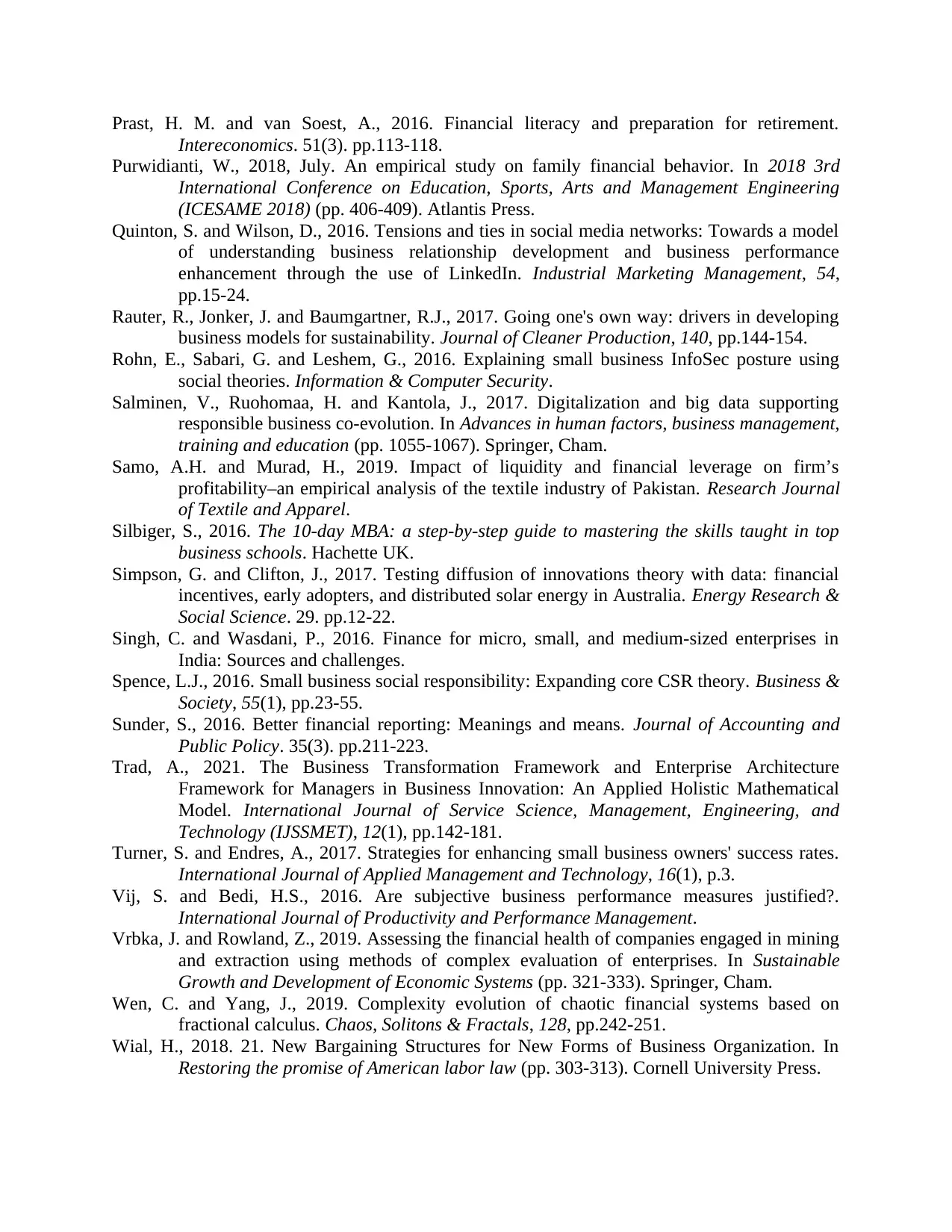
Prast, H. M. and van Soest, A., 2016. Financial literacy and preparation for retirement.
Intereconomics. 51(3). pp.113-118.
Purwidianti, W., 2018, July. An empirical study on family financial behavior. In 2018 3rd
International Conference on Education, Sports, Arts and Management Engineering
(ICESAME 2018) (pp. 406-409). Atlantis Press.
Quinton, S. and Wilson, D., 2016. Tensions and ties in social media networks: Towards a model
of understanding business relationship development and business performance
enhancement through the use of LinkedIn. Industrial Marketing Management, 54,
pp.15-24.
Rauter, R., Jonker, J. and Baumgartner, R.J., 2017. Going one's own way: drivers in developing
business models for sustainability. Journal of Cleaner Production, 140, pp.144-154.
Rohn, E., Sabari, G. and Leshem, G., 2016. Explaining small business InfoSec posture using
social theories. Information & Computer Security.
Salminen, V., Ruohomaa, H. and Kantola, J., 2017. Digitalization and big data supporting
responsible business co-evolution. In Advances in human factors, business management,
training and education (pp. 1055-1067). Springer, Cham.
Samo, A.H. and Murad, H., 2019. Impact of liquidity and financial leverage on firm’s
profitability–an empirical analysis of the textile industry of Pakistan. Research Journal
of Textile and Apparel.
Silbiger, S., 2016. The 10-day MBA: a step-by-step guide to mastering the skills taught in top
business schools. Hachette UK.
Simpson, G. and Clifton, J., 2017. Testing diffusion of innovations theory with data: financial
incentives, early adopters, and distributed solar energy in Australia. Energy Research &
Social Science. 29. pp.12-22.
Singh, C. and Wasdani, P., 2016. Finance for micro, small, and medium-sized enterprises in
India: Sources and challenges.
Spence, L.J., 2016. Small business social responsibility: Expanding core CSR theory. Business &
Society, 55(1), pp.23-55.
Sunder, S., 2016. Better financial reporting: Meanings and means. Journal of Accounting and
Public Policy. 35(3). pp.211-223.
Trad, A., 2021. The Business Transformation Framework and Enterprise Architecture
Framework for Managers in Business Innovation: An Applied Holistic Mathematical
Model. International Journal of Service Science, Management, Engineering, and
Technology (IJSSMET), 12(1), pp.142-181.
Turner, S. and Endres, A., 2017. Strategies for enhancing small business owners' success rates.
International Journal of Applied Management and Technology, 16(1), p.3.
Vij, S. and Bedi, H.S., 2016. Are subjective business performance measures justified?.
International Journal of Productivity and Performance Management.
Vrbka, J. and Rowland, Z., 2019. Assessing the financial health of companies engaged in mining
and extraction using methods of complex evaluation of enterprises. In Sustainable
Growth and Development of Economic Systems (pp. 321-333). Springer, Cham.
Wen, C. and Yang, J., 2019. Complexity evolution of chaotic financial systems based on
fractional calculus. Chaos, Solitons & Fractals, 128, pp.242-251.
Wial, H., 2018. 21. New Bargaining Structures for New Forms of Business Organization. In
Restoring the promise of American labor law (pp. 303-313). Cornell University Press.
Intereconomics. 51(3). pp.113-118.
Purwidianti, W., 2018, July. An empirical study on family financial behavior. In 2018 3rd
International Conference on Education, Sports, Arts and Management Engineering
(ICESAME 2018) (pp. 406-409). Atlantis Press.
Quinton, S. and Wilson, D., 2016. Tensions and ties in social media networks: Towards a model
of understanding business relationship development and business performance
enhancement through the use of LinkedIn. Industrial Marketing Management, 54,
pp.15-24.
Rauter, R., Jonker, J. and Baumgartner, R.J., 2017. Going one's own way: drivers in developing
business models for sustainability. Journal of Cleaner Production, 140, pp.144-154.
Rohn, E., Sabari, G. and Leshem, G., 2016. Explaining small business InfoSec posture using
social theories. Information & Computer Security.
Salminen, V., Ruohomaa, H. and Kantola, J., 2017. Digitalization and big data supporting
responsible business co-evolution. In Advances in human factors, business management,
training and education (pp. 1055-1067). Springer, Cham.
Samo, A.H. and Murad, H., 2019. Impact of liquidity and financial leverage on firm’s
profitability–an empirical analysis of the textile industry of Pakistan. Research Journal
of Textile and Apparel.
Silbiger, S., 2016. The 10-day MBA: a step-by-step guide to mastering the skills taught in top
business schools. Hachette UK.
Simpson, G. and Clifton, J., 2017. Testing diffusion of innovations theory with data: financial
incentives, early adopters, and distributed solar energy in Australia. Energy Research &
Social Science. 29. pp.12-22.
Singh, C. and Wasdani, P., 2016. Finance for micro, small, and medium-sized enterprises in
India: Sources and challenges.
Spence, L.J., 2016. Small business social responsibility: Expanding core CSR theory. Business &
Society, 55(1), pp.23-55.
Sunder, S., 2016. Better financial reporting: Meanings and means. Journal of Accounting and
Public Policy. 35(3). pp.211-223.
Trad, A., 2021. The Business Transformation Framework and Enterprise Architecture
Framework for Managers in Business Innovation: An Applied Holistic Mathematical
Model. International Journal of Service Science, Management, Engineering, and
Technology (IJSSMET), 12(1), pp.142-181.
Turner, S. and Endres, A., 2017. Strategies for enhancing small business owners' success rates.
International Journal of Applied Management and Technology, 16(1), p.3.
Vij, S. and Bedi, H.S., 2016. Are subjective business performance measures justified?.
International Journal of Productivity and Performance Management.
Vrbka, J. and Rowland, Z., 2019. Assessing the financial health of companies engaged in mining
and extraction using methods of complex evaluation of enterprises. In Sustainable
Growth and Development of Economic Systems (pp. 321-333). Springer, Cham.
Wen, C. and Yang, J., 2019. Complexity evolution of chaotic financial systems based on
fractional calculus. Chaos, Solitons & Fractals, 128, pp.242-251.
Wial, H., 2018. 21. New Bargaining Structures for New Forms of Business Organization. In
Restoring the promise of American labor law (pp. 303-313). Cornell University Press.
Secure Best Marks with AI Grader
Need help grading? Try our AI Grader for instant feedback on your assignments.
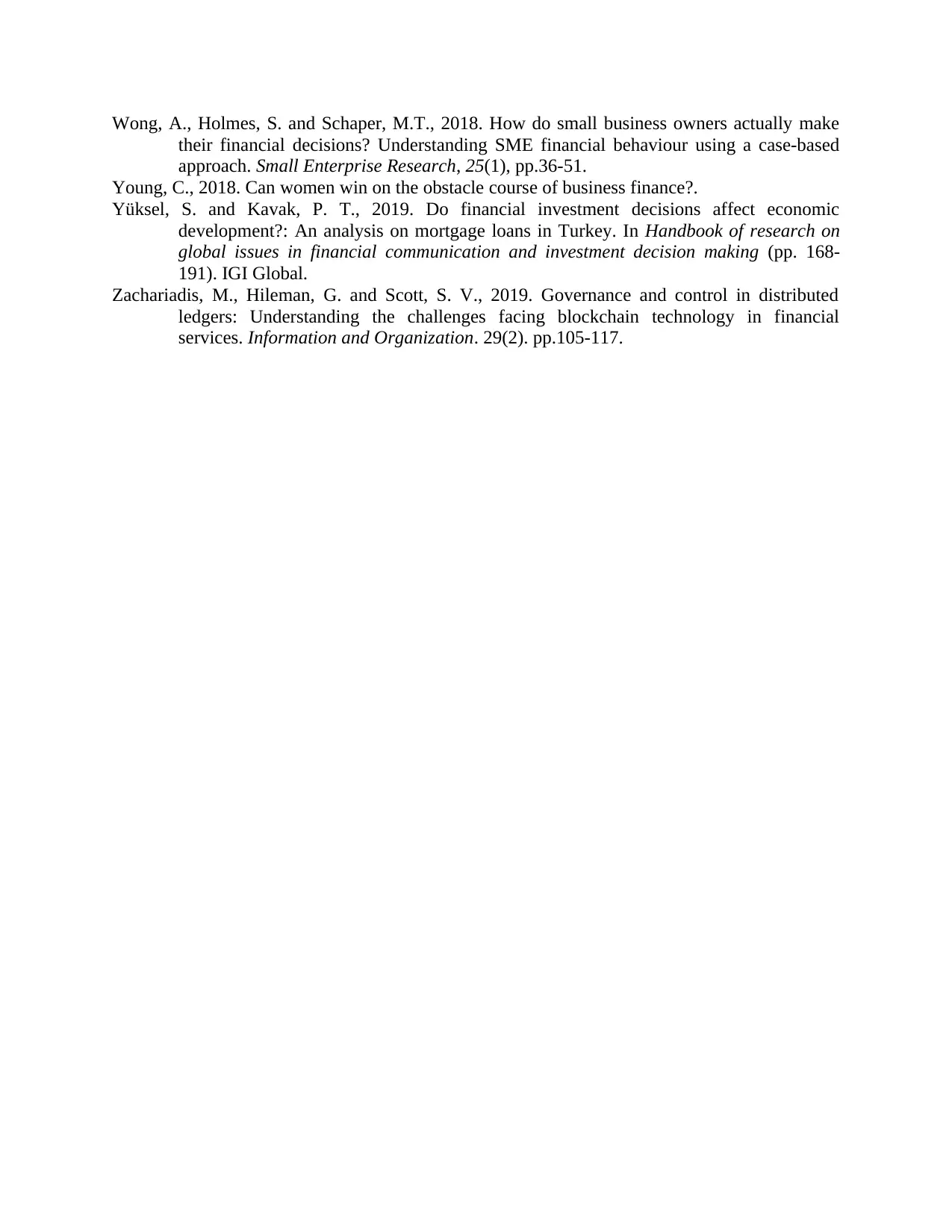
Wong, A., Holmes, S. and Schaper, M.T., 2018. How do small business owners actually make
their financial decisions? Understanding SME financial behaviour using a case-based
approach. Small Enterprise Research, 25(1), pp.36-51.
Young, C., 2018. Can women win on the obstacle course of business finance?.
Yüksel, S. and Kavak, P. T., 2019. Do financial investment decisions affect economic
development?: An analysis on mortgage loans in Turkey. In Handbook of research on
global issues in financial communication and investment decision making (pp. 168-
191). IGI Global.
Zachariadis, M., Hileman, G. and Scott, S. V., 2019. Governance and control in distributed
ledgers: Understanding the challenges facing blockchain technology in financial
services. Information and Organization. 29(2). pp.105-117.
their financial decisions? Understanding SME financial behaviour using a case-based
approach. Small Enterprise Research, 25(1), pp.36-51.
Young, C., 2018. Can women win on the obstacle course of business finance?.
Yüksel, S. and Kavak, P. T., 2019. Do financial investment decisions affect economic
development?: An analysis on mortgage loans in Turkey. In Handbook of research on
global issues in financial communication and investment decision making (pp. 168-
191). IGI Global.
Zachariadis, M., Hileman, G. and Scott, S. V., 2019. Governance and control in distributed
ledgers: Understanding the challenges facing blockchain technology in financial
services. Information and Organization. 29(2). pp.105-117.
1 out of 17
Related Documents
Your All-in-One AI-Powered Toolkit for Academic Success.
+13062052269
info@desklib.com
Available 24*7 on WhatsApp / Email
![[object Object]](/_next/static/media/star-bottom.7253800d.svg)
Unlock your academic potential
© 2024 | Zucol Services PVT LTD | All rights reserved.

